Access Class 11 Maths NCERT Solutions Chapter 2 Relations and Functions Ex 2.3, contains solutions for all Exercise 2.3 Class 11 questions.
Relations and Functions Class 11 NCERT Solutions Maths Chapter 2 Exercise 2.3
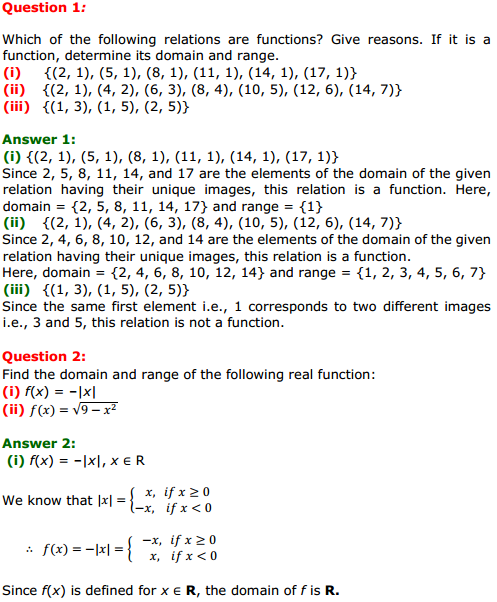
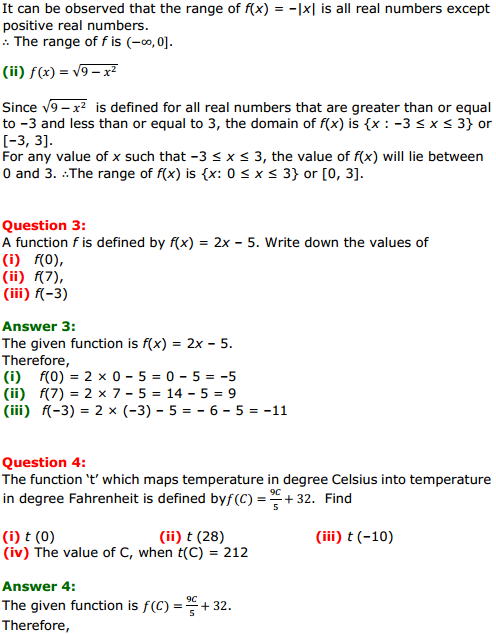
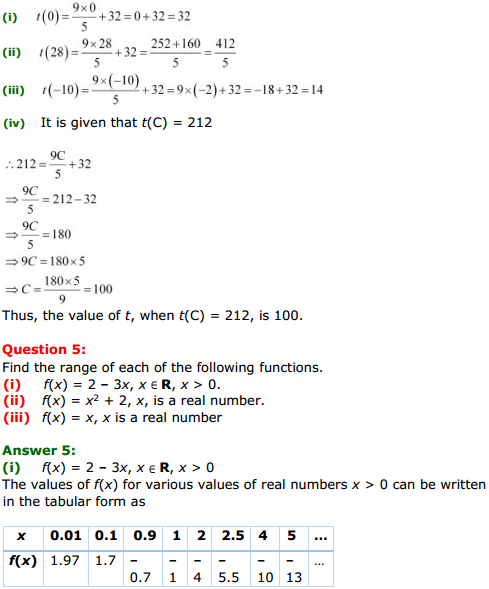
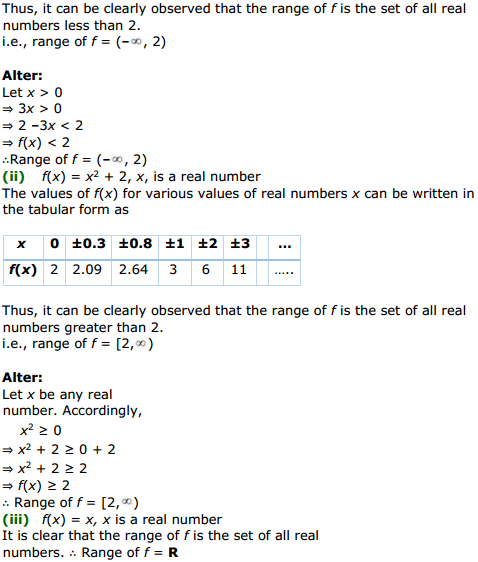
CBSE Class 11
Access Class 11 Maths NCERT Solutions Chapter 2 Relations and Functions Ex 2.3, contains solutions for all Exercise 2.3 Class 11 questions.




Access Class 11 Maths NCERT Solutions Chapter 2 Relations and Functions Ex 2.2, contains solutions for all Exercise 2.2 Class 11 questions.
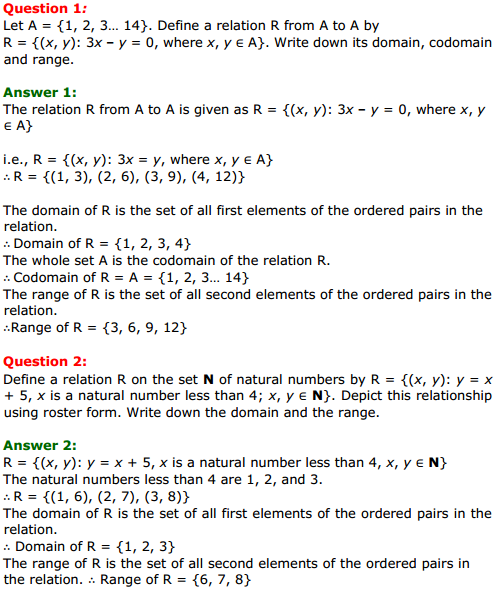
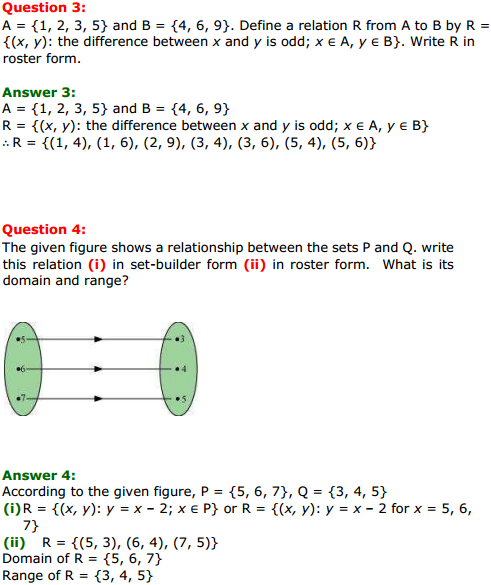
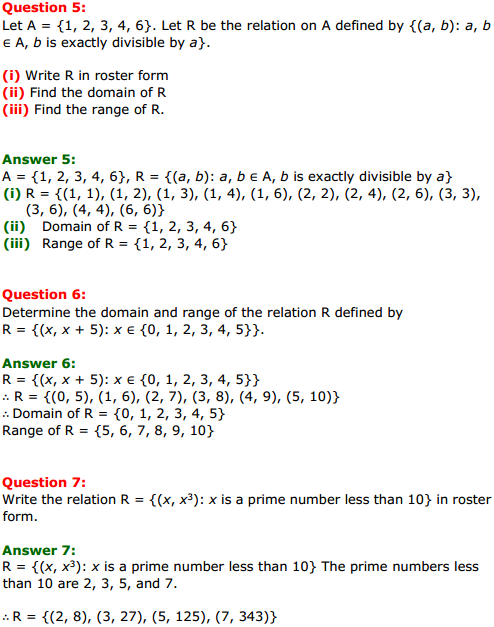
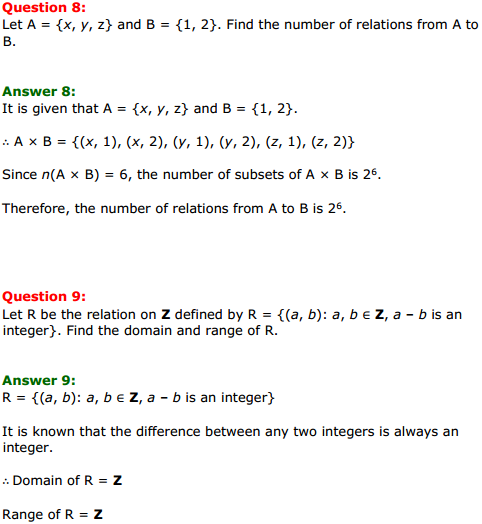
Access Class 11 Maths NCERT Solutions Chapter 2 Relations and Functions Ex 2.1, contains solutions for all Exercise 2.1 Class 11 questions.
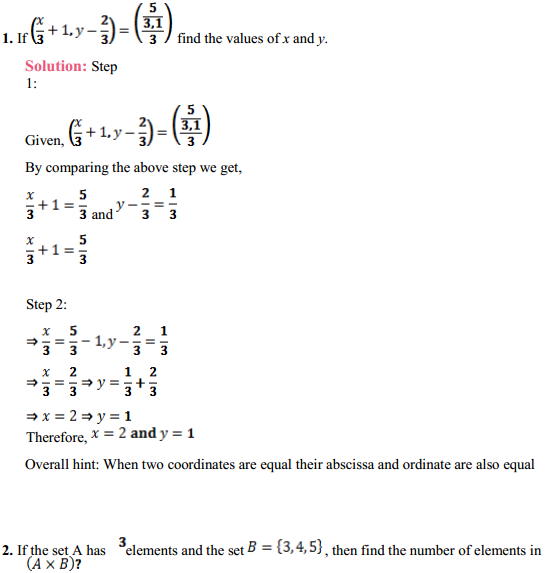
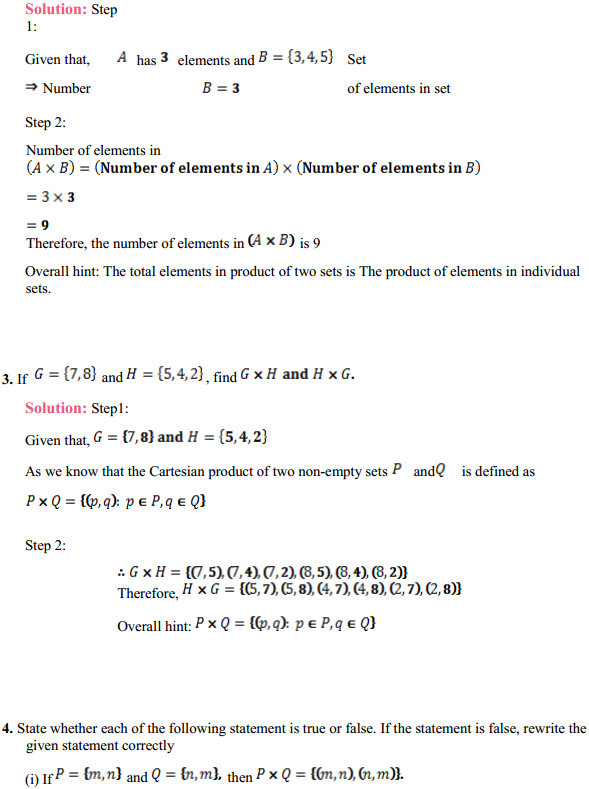

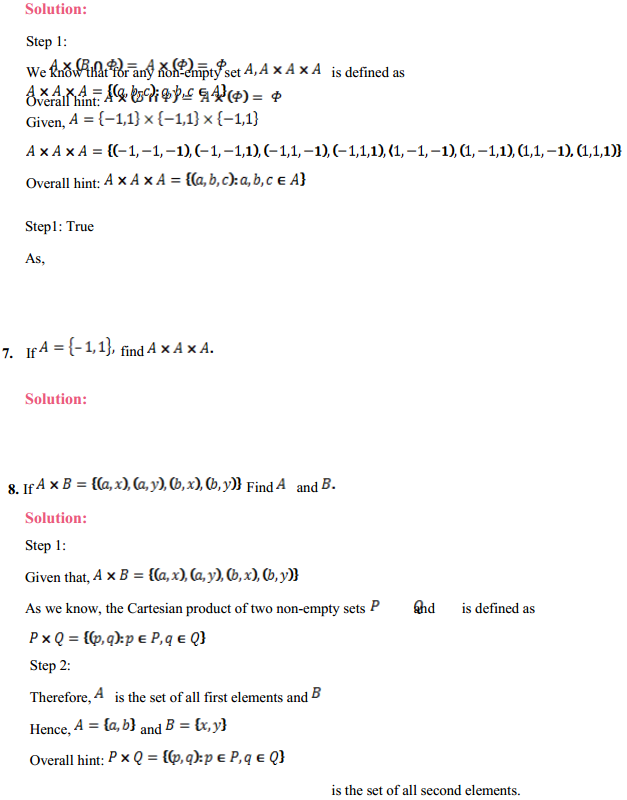

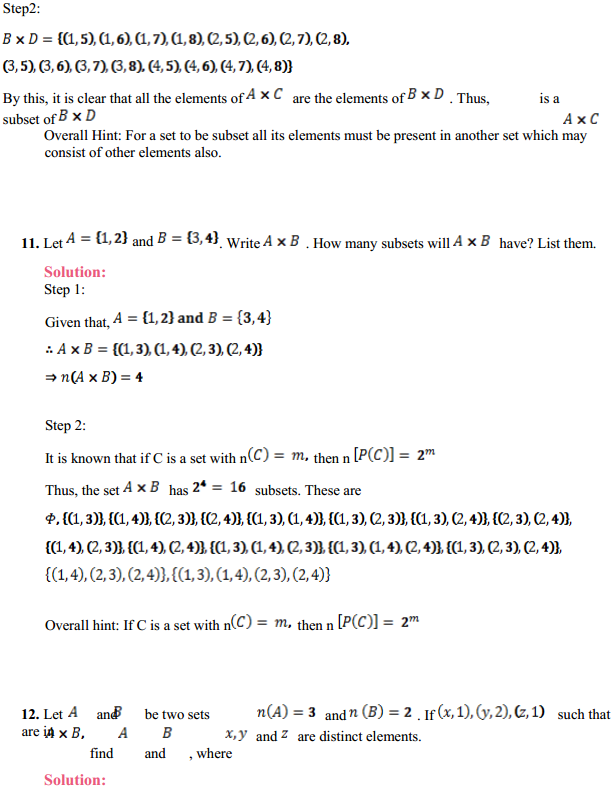
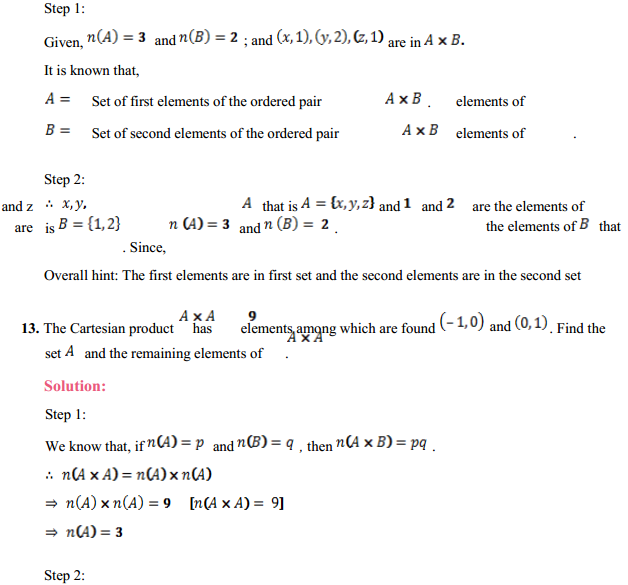

NCERT Solutions for Class 7 Hindi Vasant Chapter 11 रहीम के दोहे (रहीम) are part of NCERT Solutions for Class 7 Hindi. Here we have given NCERT Solutions for Class 7 Hindi Vasant Chapter 11 रहीम के दोहे (रहीम).
| Board | CBSE |
| Textbook | NCERT |
| Class | Class 7 |
| Subject | Hindi Vasant |
| Chapter | Chapter 1 |
| Chapter Name | हम पंछी उन्मुक्त गगन के |
| Number of Questions Solved | 5 |
| Category | NCERT Solutions |
पाठ्यपुस्तक के प्रश्न-अभ्यास
(पृष्ठ 84-85)
दोहे से
प्रश्न 1.
पाठ में दिए गए दोहों की कोई पंक्ति कथन है और कोई कथन को प्रमाणित करने वाला उदाहरण। इन दोनों प्रकार की पंक्तियों को पहचान कर अलग-अलग लिखिए।
उत्तर-
पाठ में वर्णित पहले और दूसरे दोहे में किसी प्रकार का उदाहरण प्रस्तुत नहीं किया गया है। दोहों में वर्णित निम्न पंक्ति
कथन है-
कहि रहीम संपति सगे, बनत बहुत बहु रीति।।
विपति कसौटी जे कसे, तेई साँचे मीत ॥
यानी संकट में जो हमारी सहायता करता है, वही हमारा सच्चा मित्र होता है।
जाल परे जल जात बहि, तजि मीनन को मोह।।
रहिमन मछरी नीर को, तऊ न छाँड़ति छोह ॥
मछली जल से अत्यधिक प्रेम करती है,
वह कभी भी जल का साथ नहीं छोड़ती जबकि जल, जाल पड़ते ही मछली को छोड़ देता है।
निम्न पंक्तियों में कथन को प्रमाणित करने के उदाहरण हैं
तरुवर फल नहिं खात है, सरवर पियत न पान (उदाहरण)
कहि रहीम परकाज हित, संपति-संचहिं सुजान (कथन)-3
निस्वार्थ भावना से दूसरों का हित करना चाहिए, जैसे पेड़ अपने फल नहीं खाते, सरोवर अपना जल नहीं पीते और सज्जन
धन संचय अपने लिए नहीं करते।
थोथे बादर क्वार के, ज्यों रहीम घहरात।
धनी पुरुष निर्धन भए, करें पाछिली बात ॥
कई लोग गरीब होने पर भी दिखावे हेतु अपनी अमीरी की बातें करते हैं, जैसे आश्विन के महीने में बादल केवल गरजते हैं
बरसते नहीं हैं।
मनुष्य को सुख-दुख समान रूप से सहने की शक्ति रखनी चाहिए; जैसे—धरती सरदी, गरमी व बरसात सभी मौसम समान
रूप से सहती है।
प्रश्न 2.
रहीम ने क्वार के मास में गरजनेवाले बादलों की तुलना ऐसे निर्धन व्यक्तियों से क्यों की है जो पहले कभी धनी थे और बीती बातों को बताकर दूसरों को प्रभावित करना चाहते हैं? दोहे के आधार पर आप सावन के बरसने और गरजनेवाले बादलों के विषय में क्या कहना चाहेंगे?
उत्तर
रहीम ने क्वार के मास में गरजनेवाले बादलों की तुलना ऐसे निर्धन व्यक्तियों से की है जो पहले कभी धनी थे और अपनी बीती बातें बताकर दूसरों को प्रभावित करना चाहते हैं। ऐसा कवि ने इसलिए किया क्योंकि क्वार मास के बादल बरसने वाले न होकर खोखले होते हैं ठीक वैसे ही जैसे धनी से निर्धन हो जाने वाले लोग धनहीन होते हैं। अपने इस दोहे में भी रहीम ने स्पष्ट रूप से यही कहा है कि क्वार के महीने में बादल केवल गहराते हैं, जबकि सावन के महीने में बादल जमकर बरसते हैं।
दोहों से आगे
नीचे दिए गए दोहों में बताई गई सच्चाइयों को यदि हम अपने जीवन में उतार लें तो उनके क्या लाभ होंगे? सोचिए और लिखिए-
( क ) तरुवर फल …………… सचहिं सुजान।।
(ख) धरती की-सी …………….. यह देह।।
उत्तर
( क )
इस पंक्ति में मुख्य रूप से रहीम ने यही कहना चाहा है कि हमें निस्वार्थ भावना से दूसरों के सहायक होना चाहिए। यदि हम इस सच्चाई को अपने जीवन में उतार लें अर्थात् अपना लें तो अवश्य ही समाज का कल्याणकारी रूप हमारे सामने आएगा और राष्ट्र सुंदर छवि प्रस्तुत करेगा।
( ख)
इसमें रहीम ने शिक्षा देनी चाही है कि मनुष्य को धरती की भाँति सहनशील होना चाहिए। यदि इस सत्य को हम अपनाएँ तो हम जीवन में आने वाले सुख-दुख को सहज रूप से स्वीकार कर सकेंगे। अपने मार्ग से कभी विचलित न होंगे। ऐसा करने से हमें प्रत्येक कार्य में सफलता अवश्य मिलेगी।
भाषा की बात
प्रश्न 1.
निम्नलिखित शब्दों के प्रचलित हिंदी रूप लिखिए
जैसे- परे-पड़े ( रे – डे)
बिपति, बादर, मछरी, सीत
उत्तर-
बिपति-विपत्ति, मछरी-मछली, बादर-बादल सीत-शीत।
प्रश्न 2.
नीचे दिए उदाहरण पढ़िए
( क ) बनत बहुत बहु रीत।
( ख ) जाल परे जल जात बहि।
• उपर्युक्त उदाहरणों की पहली पंक्ति में ‘ब’ का प्रयोग कई बार किया गया है और दूसरी में ‘ज’ का प्रयोग। इस प्रकार बार-बार एक ध्वनि के आने से भाषा की सुंदरता बढ़ जाती है। वाक्य रचना की इस विशेषता के अन्य उदाहरण खोजकर लिखिए।
उत्तर
( क ) दावे न दवे
(ख) संपति-सचहिं सुजान
We hope the NCERT Solutions for Class 7 Hindi Vasant Chapter 11 रहीम के दोहे (रहीम) help you. If you have any query regarding NCERT Solutions for Class 7 Hindi Vasant Chapter 11 रहीम के दोहे (रहीम), drop a comment below and we will get back to you at the earliest.
Here we are providing Class 11 Physics Important Extra Questions and Answers Chapter 3 Motion in a Straight Line. Important Questions for Class 11 Physics with Answers are the best resource for students which helps in Class 11 board exams.
The Velocity Calculator is a handy physics tool to quickly get your answer.
Question 1.
Can a moving body have relative velocity zero with respect to another body? Give an example.
Answer:
Yes, two trains running on two parallel tracks with the same velocity in the same direction.
Free Projectile Motion Calculator – calculate projectile motion step by step.
Question 2.
Can there be motion in two dimensions with acceleration in only one dimension?
Answer:
Yes, projectile motion.
Question 3.
Is it true that a body is always at rest in a frame that is fixed to the body itself?
Answer:
Yes.
Question 4.
Tell under what condition a body moving with uniform velocity can be in equilibrium?
Answer:
When the net force on the body is zero.
Question 5.
What does the speedometer records: the average speed or the instantaneous speed?
Answer:
It records (or measures) the instantaneous speed.
Question 6.
Can an object be accelerated without speeding up or slowing down? Give examples,
Answer:
Yes, circular motion.
Question 7.
Is it possible to have the rate of change of velocity constant while the velocity itself changes both in magnitude and direction? Give an example.
Answer:
Yes, in projectile motion.
Question 8.
Which motion is exactly represented by Δs = vΔt?
Answer:
It Represents motion with uniform velocity.
Question 9.
In which frame of reference is the body always at rest?
Answer:
The body is always at rest in the frame attached to it i. e. inertial frame of reference.
Question 10.
What is common between the two graphs shown in figs, (a) and (b)?
Answer:
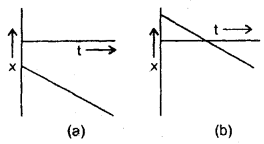
Both these graphs represent that the velocity is negative.
Question 11.
What is common between the two graphs shown in figs, (a) and (b)?
Answer:
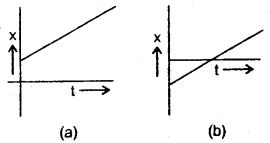
Both these graphs represent that velocity is positive.
Question 12.
What is meant by a point object in Physics?
Answer:
An object is said to be a point object if its dimensions are very small as compared to the distance covered by it.
Question 13.
The displacement of a body is zero. Is the distance covered by it is necessarily zero?
Answer:
No.
Question 14.
Which of the velocity or speed is measured by the speedometer of a vehicle?
Answer:
Speed.
Question 15.
Can you think of a situation where a body falling under gravity has constant velocity? Give example.
Answer:
Yes, the terminal velocity of a body.
Question 16.
Give an example of a motion which even though is accelerated motion yet it is called uniform motion.
Answer:
Uniform circular motion.
Question 17.
How many-dimensional motion does the following have?
(a) Train moving fast on its track.
Answer:
One dimensional motion.
(b) A lizard moving on a wall in a room.
Answer:
Two-dimensional motion.
(c) Kite flying in the sky.
Answer:
and
(d) Bee flying in a closed room.
Answer:
Three-dimensional motion.
Question 18.
When is the average velocity over an interval of time becomes equal to instantaneous velocity?
Answer:
When the velocity is constant.
Question 19.
A coolie carries a bag of luggage from one side of a platform to another side on the same platform. How far vertically the load is shifted?
Answer:
Zero.
Question 20.
The displacement of a body is proportional to the square of time along a straight line. Is the body moving with constant velocity or constant acceleration?
Answer:
It is moving with constant acceleration.
Question 21.
When the train in which you are sitting starts moving by the side of another train without jerks, you find that the other train is moving but when you look to the platform you find that your train is moving. Name the phenomenon responsible for such a motion.
Answer:
Relative velocity is the phenomenon responsible for such a motion.
Question 22.
Under what condition the magnitude of the average velocity of a particle is equal to the average speed?
Answer:
The magnitude of the average velocity of a particle is equal to the average speed if it moves with constant velocity.
Question 23.
Two particles A and B are moving along the same straight line with B being ahead of A. Velocities remaining unchanged, what would be the effect on the magnitude of relative velocity if A is ahead of B? ’
Answer:
The magnitude of the relative velocity will remain the same i.e. no effect on its magnitude.
Question 24.
Define the speed of the object.
Answer:
The speed of an object is defined as the distance covered by it per unit of time.
Question 25.
Why the speed of an object cannot be negative?
Answer:
The speed of an object cannot be negative because the distance can never be negative.
Question 26.
Can a body have zero velocity and still accelerating?
Answer:
Yes.
Question 27.
Can the direction of the velocity of a body change, when acceleration is constant?
Answer:
Yes.
Question 28.
Is the acceleration of a car is greater when the accelerator is pushed to the floor or when the brake pedal is pushed hard?
Answer:
The acceleration of the car is greater when the brake pedal is pushed hard because the car comes to rest suddenly i. e. the rate of change of velocity of the car is large in this case, so the acceleration.
Question 29.
The displacement is given by x = 2 + 4t + 5t2. Find the value of instantaneous acceleration.
Answer:
a = \(\frac{\mathrm{d}^{2} \mathrm{x}}{\mathrm{dt}^{2}}\) = 10
Question 30.
A stone is thrown vertically upwards from the surface of Earth. What is the direction of the velocity and acceleration of the stone?
(a) on its upward motion
Answer:
Velocity is vertically upward and acceleration is vertically downward.
(b) on its downward motion?
Answer:
Both velocity and acceleration are vertically downward.
Question 31.
Can Earth be regarded as a point object if only the orbital motion of Earth around the Sun is considered? Why?
Answer:
Yes. This is because the size of Earth is very small as compared to the size of the orbit of the Earth around the Sun.
Question 32.
The motion of two persons is shown by two straight lines on a displacement time graph intersecting each other at a certain point. What information do you get from the point of intersection?
Answer:
This means that the two persons cross each other at a certain place at a given instant of time.
Question 33.
Following two equations represents the x – t relation for the motion of an objects.
x (t) = x(0) + v(0)t + \(\frac{1}{2}\) at2
and x(t) = v(0)t + \(\frac{1}{2}\) at2
What is the difference between them?
Answer:
The first equation is a more general form of motion as it contains information regarding the initial position of the object.
Question 34.
Can the speed of a body change if its velocity is constant? Why?
Answer:
No, the speed of a body cannot change if its velocity is constant which means that both the magnitude and direction of velocity do not change. The magnitude of velocity is speed, so speed cannot change.
Question 35.
If the instantaneous velocity of a particle is zero, will its instantaneous acceleration be necessarily zero?
Answer:
No.
Question 36.
What is the shape of the displacement time graph of a particle having an average velocity equal to its instantaneous velocity?
Answer:
In this case, the velocity is uniform, so the x – t graph is a straight line.
Question 37.
Can there be a two-dimensional motion with acceleration in one dimension only? Give example.
Answer:
Yes, a projectile motion which is two-dimensional one has acceleration only in one dimension i.e. vertically downward.
Question 38.
Under what condition will the distance and displacement of a moving object will have the same magnitude?
Answer:
The distance and displacement of a moving object will have the same magnitude when it is moving with uniform velocity along a straight line.
Question 39.
Under what condition an object in motion cannot be considered a point object?
Answer:
A moving object cannot be considered as a point object if its size is not negligible as compared to the distance travelled by it.
Question 40.
Define a point object.
Answer:
It is defined as an object having dimensions (length, breadth, thickness etc.) very small as compared to the distance covered by it.
Question 41.
Is the following graph possible for the motion of a particle moving along a straight line?
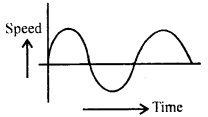
Answer:
No.
Question 42.
Explain why the graph in the above question is not possible?
Answer:
This is because the speed for a given time is negative and speed is always positive.
Question 43.
Why the following graph is not possible for the motion of a particle moving along a straight line?
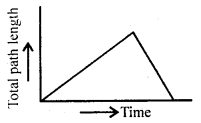
Answer:
This is because here the path length decreases with time while it must either increase or must remain constant.
Question 44.
What happens to kinematic equations under time reversal?
Answer:
The kinematic equations of motion don’t change in the form under time reversal i.e. if t is replaced by -t.
Question 45.
What happens to the uniform motion of a body when it is given an acceleration at right angles to its motion?
Answer:
The body will come in a circular motion when it is given an acceleration at right angles to its motion.
Question 46.
To deal with physical phenomena, we consider objects even as big as Sun a point objects. Can you name physical phenomena in which Earth cannot be taken as a point object?
Answer:
The occurrence of solar or lunar eclipse does not allow Earth to be taken as a point object otherwise the phenomena cannot be explained.
Question 47.
The average velocity of a body moving with uniform acceleration is given by \(\frac{1}{2}\) (u + v). Ii the acceleration changes from point to point can the average velocity be still given by this expression? Give reason.
Answer:
No, the average velocity cannot be given by \(\frac{1}{2}\) (u + v) in case the acceleration varies from point to point i.e. if it is not uniform. This is because the slope of the v-t graph does not remain the same at all points.
Question 48.
Acceleration is defined as the rate of change of velocity. Suppose we call the rate of change of acceleration SLAP. Then (i) What is the unit of SLAP.
Answer:
SLAP = Acceleration/time (By definition).
∴ Its unit will be = \(\frac{\mathrm{ms}^{2}}{\mathrm{~s}}\) = ms-3.
(ii) How can you calculate instantaneous SLAP?
Answer:
Average SLAP = \(\frac{\Delta \mathrm{a}}{\Delta \mathrm{t}}\)
∴ Instantaneous SLAP = Limiting value of average SLAP

Question 49.
Why is the time stated twice in stating acceleration?
Answer:
Since acceleration is the double rate of change of displacement
i. e. a = \(\frac{\mathrm{d}^{2} \mathrm{x}}{\mathrm{dt}^{2}}\), so time is stated twice in stating acceleration.
Question 50.
Separate the following in one, two and three-dimensional motion :
(a) a kite flying on a windy day.
(b) an insect crawling on a globe.
(c) a carom coin rebounding from the side of the board,
(d) a planet revolving around its star.
(e) the motion of a boat.
(f) the motion of a dropped body.
(g) the motion of a tennis ball.
(h) a charged particle moving under an electric field.
(i) movement of a saw while cutting wood.
(j) molecular motion.
(k) a charged particle moving under a magnetic field.
Answer:
Question 1.
Prove that the average velocity of a particle over an interval of time is either smaller than or equal to the average speed of the particle over the same interval.
Answer:
Average velocity is defined as the ratio of the total displacement to the total time. Average speed is defined as the ratio of the total distance to the total time. Since displacement is less than or equal to the distance, therefore the average velocity is less than or equal to the average speed.
Question 2.
Two trains each of the length 109 m and 91 m are moving in opposite directions with velocities 34 km h-1 and 38 km h-1 respectively. At what time the two trains will completely cross each other?
Answer:
Let l1, l2 be the lengths of the two trains.
v1, v2 be their velocities respectively.
∴ l1 = 109m, l2 = 91 m, v1 = 34kmh-1, v2 = 38kmh-1.
As the trains are moving in opposite directions so relative velocity of the trains is given by
v1 – (- v2) = v1 + v2
= 34 + 38 = 72 kmh-1
= 72 × \(\frac{5}{18}\) = 20 ms-1
Total distance to be covered by the two trains in crossing each other
= l1 + l2= 109 + 91 = 200 m
If t be the time taken in crossing, then t can be calculated using the relation
x = vt
or
t = \(\frac{200}{20}\) = 10s
Question 3.
Ambala is at a distance of 200 km from Delhi. Ram sets out from Ambala at a speed of 60 km h-1 and Sham set out at the same time from Delhi at a speed of 40 km h-1. When will they meet?
Answer:
S = 200 km. Let VR and vs be the speeds of Ram and Sham respectively moving in opposite directions.
∴ vR = 60 kmh-1, vS = 40 kmh-1.
∴ Relative velocity of Ram w.r.t. Sham is
VRS = VR – (- VS)
= VR + VS
= 60 + 40 = 100 kmh-1
If t = time after which they will meet, then
t = time taken in covering 200 km distance with VRS
i.e. t = \(\frac{200}{v_{\mathrm{RS}}}=\frac{200 \mathrm{~km}}{100 \mathrm{kmh}^{-1}}\) = 2h.
∴ Time after which they meet = 2h.
Question 4.
A car travelling at a speed of 60 km h-1 on a straight road is ahead of a scooter travelling at a speed of 40 km h-1. How would the relative velocity be altered if the scooter is ahead of the car?
Answer:
vc = speed of car = 60 kmh-1
vs = speed of scooter = 40 kmh-1
vcs = relative velocity of car w.r.t. scooter
= vc – vs
= 60 – 40
= 20 kmh-1
Similarly vsc = relative velocity of scooter w.r.t. car
= vs – vc
= 40 – 60
= – 20 kmh--1
Thus we conclude that the magnitude of the relative velocity is the same in both cases but the direction of relative velocity is reversed if the scooter is ahead of the car.
Question 5.
Draw the position-time graphs for two objects initially occupying different positions but having zero relative velocity.
Answer:
The positive T time graphs for two objects initially occupying different positions but having zero relative velocity are parallel to each other as shown in Fig.
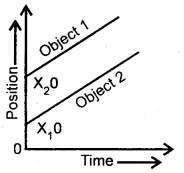
Question 6.
A ball is thrown vertically upward with a velocity of 20 ms-1. It takes 4 seconds to return to its original position. Draw a velocity-time graph for the motion of the ball and answer the following questions:
At which point P, Q, R, the stone has :
(a) reached its maximum height.
(b) stopped moving?
Answer:
Let P represent the initial position at the time when the ball is thrown vertically upward.
Q represents the highest point reached by the ball.
R represents the original position of the ball after 4 seconds.
Thus the velocity-time graph for the motion of the ball is as shown in Fig.
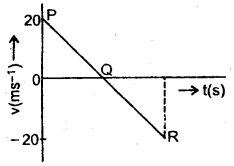
(a) We know that at the highest point, the velocity of the object is zero. So stone will reach its maximum height corresponding to point Q.
(b) The stone has stopped moving at point Q because at Q, v = 0.
Question 7.
“It is the velocity and not the acceleration which decides the direction of motion of a body.” Justify this statement with the help of a suitable example.
Answer:
The direction of velocity is always in the direction of motion of the body whereas the direction of acceleration may or may not be in the direction of motion of the body. Thus we conclude that it is the velocity that decides the direction of motion of the body.
Example: When a ball is thrown vertically upwards, the direction of motion of the ball and velocity is the same i.e. vertically upwards. On the other hand, the acceleration due to gravity on the ball acts vertically downwards i.e. opposite to the direction of motion of the ball.
Question 8.
Two buses A and B starting from the same point move in a mutually perpendicular direction with speeds uA km h-1 and uB km h-1 respectively. Calculate the relative velocity of A w.r.t B.
Answer:
Since uA and uB are in mutually perpendicular directions, they will cover uA and uB km in one hour respectively. Thus if v km be the separation between them in one hour,
Then v = \(\sqrt{\mathrm{u}_{\mathrm{A}}^{2}+\mathrm{u}_{\mathrm{B}}^{2}}\)
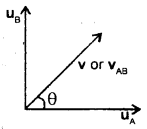
Thus if vAB be the relative speed of A w.r.t. B, then
vAB = \(\sqrt{\mathrm{u}_{\mathrm{A}}^{2}+\mathrm{u}_{\mathrm{B}}^{2}}\) kmh …(1)
If θ be the direction of vAB w.r.t. uA, Then
tan θ = \(\frac{u_{A}}{v_{A B}}=\frac{u_{A}}{\sqrt{u_{A}^{2}+u_{B}^{2}}}\) …(2)
Thus, equations (1) and (2) give the magnitude and direction of relative velocity of A w.r.t. B.
Question 9.
A draw velocity-time graph for a body which
(i) accelerates uniformly from rest,
Answer:
The required velocity-time graph is shown in Fig. here
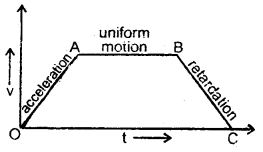
OA part of the graph represents the uniformly accelerated motion of the body.
(ii) then moves with a uniform velocity and
Answer:
AB part of the graph represents motion with uniform velocity.
(iii) finally retarded uniformly.
Answer:
BC part of the graph represents motion with uniform retardation of the body.
Question 10.
From a velocity-time graph, how do you calculate the average acceleration of a moving body?
Answer:
The slope of the velocity-time curve gives the acceleration of the body. For this purpose, we take a small interval of time Δt and a corresponding change in velocity Δv such that Δt = t2 – t1 and Δv = v2 – v1. Over a very small interval of time Δt, arc AB may be considered as a chord AB, then.

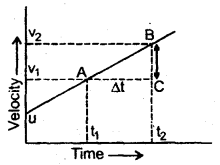
Question 11.
State whether the following two graphs in Fig. here represent the same type of motion or not. Name the motion of the particle.
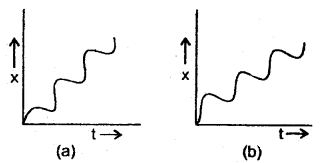
Answer:
Yes. Both of these graphs represent the same type of motion. The motion of the particle represented by these graphs is non-uniform motion i.e. the particle is moving with variable velocity.
Question 12.
Draw the velocity-time graph for an object moving with uniform velocity. What does it show for t < 0?
Answer:
As the object moves with uniform velocity, the magnitude and direction of its velocity remain the same at all points of its path. Thus v – t graph’ is a straight line parallel to the time axis as shown in Fig. here.
For t < 0, the v – t graph shows that the object is at rest till t = 0.
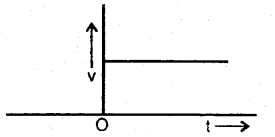
Question 13.
The displacement time graph of a body is shown in the figure below. What does the curve for t < 0 and t > 0 show?
Answer:
The line ∥ to t – axis in fig. shows that the object is at rest t ∥ t = 0. For t > 0, it shows that it is still at rest but at some another poi it at a distance XQ from the point for t < 0.
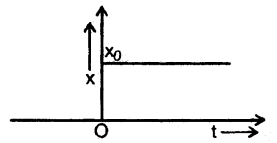
Question 14.
Distinguish between one, two and three-dimensional motion.
Answer:
The motion of an object along a straight line in a fixed direction is called one-dimensional motion.
Question 15.
A ball thrown upward reaches a height and comes bad downward. Out of the following statements, which one is true for displacement, velocity and acceleration.
(a) It varies continuously but never changes the sign.
(b) It varies continuously with the maximum, in the beginning, being zero at the top.
(c) It remains constant throughout the course of the journey.
(d) It only changes the sign when the ball is at the top.
Answer:
Question 16.
Derive the expression for the time taken by a body dropped from a height h to reach at Earth.
Answer:
Here,
initial velocity, u = 0
acceleration, a = g
distance covered, S = h
Let t = time taken
Using the relation

Question 17.
In which of the following cases, the body may be considered a point object:
(a) A railway carriage moving without jerks between two stations.
(b) A monkey sitting on the shoulder of a cyclist moving smoothly in a circular track.
1 A beaker tumbling down the edge of a table, A spinning cricket ball that turns sharply on hitting the ground.
Answer:
(a) and (b) as the distance moved by the bodies is much larger; the size of the body.
Question 18.
What do you understand by positive and negative time?
Answer:
The origin of time is called zero time. The instant of time which is after the origin of time is called positive time and the instant of, which is taken before the origin of time is called negative time.
Question 19.
If the displacement time graph of a particle is parallel to the displacement axis (b) the time axis, what will be the velocity particle? Why?
Answer:
(a) When the displacement-time graph is parallel to the displacement axis, the velocity of the particle is infinity.
We know that velocity = \(\frac{\Delta \mathrm{x}}{\Delta \mathrm{t}}\)
when the graph is parallel to the displacement axis, then Δt = 0, so velocity = infinity.
(b) When the displacement-time graph is parallel to the time axis, the velocity of the particle is zero as in this case Δx = 0.
Question 20.
An object is in uniform motion along a straight line. What will be its position-time graph if
(a) x0 = +ve, v = +ve,
(b) x0 = +ve, v = – ve,
(c) x0 = – ve, v = +ve,
(d) x0 = – ve, v = – ve.
The letters x0 and v represent the position of the object at time t = 0 and the uniform velocity of the object respectively.
Answer:
The position of an object at any time t moving with a uniform velocity along a straight line is given by
x = x0 + vt ….(1)

(a) If X0 > 0, v > 0 i.e. both positive, then the position-time graph is as shown in Fig. (a).
(b) If X0 = +ve, v = – ve, then the x – t graph is as shown in Fig. (b).
(c) If X0 = – ve, v = +ve, then the x – t graph is as shown in Fig. (c).
(d) If both x0 and v are – ve, then the x -t graph is as shown in Fig. (d).
Question 21.
Define displacement. What are its characteristics?
Answer:
It is defined as the change in the position of an object in a particular direction.
Characteristics of displacement:
Question 23.
What are the important points about the uniform motion?
Answer:
The following are some important points about the uniform motion:
Question 24.
A car is being driven at a uniform velocity u. The driver suddenly puts his foot on the accelerator and the speed increases to v. Unfortunately after that his brakes failed. Show his velocity-time graph.
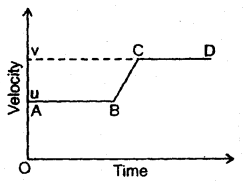
Answer:
Initially, the graph will be parallel to the time axis and is represented by AB when the velocity is uniform. Thereafter it is accelerated and its velocity becomes v. The car will then move with this velocity represented by CD.
Question 25.
Draw position-time graphs of two objects moving along a straight line when their relative velocity is (a) zero and (b) non-zero.
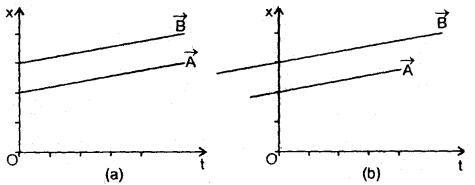
Answer:
The motion of two objects moving along a straight line can be represented by two parallel lines on the position-time graph.
In case of zero relative velocity the two vectors \(\vec{A}\) and \(\vec{B}\) will have the same magnitude as shown in fig. (a) and when the relative velocity is non-zero, the length of the two vectors i.e. the magnitude of vectors is different even though they are parallel and is shown in fig.(b).
Question 26.
Prove that the distance travelled by an object in nth second is given by
Snth = u + \(\frac{a}{2}\) (2n – 1)
Answer:
Derivation: Let Sn and Sn-1 be the distances covered by an object in n and n-1 seconds respectively.
Let u = its initial velocity
a = acceleration produced in the object
∴ Using the relation

If Snth is the distance covered by the object in nth second. Then
Snth = Sn – Sn-1
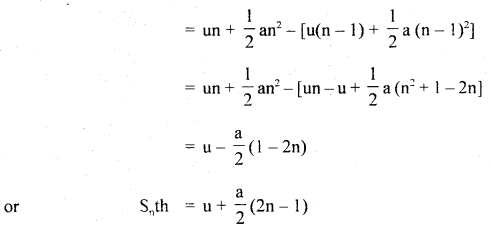
Hence proved.
Question 27.
Is it possible that the velocity of an object be in a direction other than the direction of acceleration? When?
Answer:
Yes, when a body moves in a circular path, then the direction of the velocity is along the tangent to the point on the circle and the acceleration is always towards its centre.
Question 28.
Is the rate of change of acceleration with the time important to describe the motion of a body? Why?
Answer:
No, because it is observed that only velocity and acceleration are sufficient to understand and explain the motion of a body.
Question 29.
Explaining with an example, why does a person sitting in a train think that the other train is at rest when both are moving on parallel tracks with the same speed and in the same direction?
Answer:
This is because the relative velocity of the train in which the person is sitting w.r.t. the other train is zero.
e.g. Let two trains A and B are moving along east with a velocity of 50 km/h i.e. vA = vB = 50 kmh1.
∴ relative velocity of A w.r.t. B is given by
VAB = vA – vB = 50 – 50 = 0.
Question 30.
Can a body be said to be at rest as well as in motion? Explain.
Answer:
Yes, both rest and motion are relative terms. A body at rest w.r.t. one object may be in motion w.r.t. another object, e.g. a person sitting in a moving train is at rest w.r.t. other passengers in the train but at the same time, he is in motion w.r.t. the surroundings (trees or buildings) on the side of the track.
Question 1.
Define the following terms :
(a) speed
Answer:
Speed : It is defined as the time rate of change of position
i. e. distance of an object.
i.e. Speed = \(\frac{\text { Distance travelled by the object }}{\text { Time taken }}\)
(b) uniform speed
Answer:
Uniform Speed: An object is said to be moving with uniform speed if it covers equal distances in equal small intervals of time.
(c) variable speed
Answer:
Variable Speed: An object is said to be moving with variable speed if it covers equal distances in unequal small intervals of time.
(d) average speed
Answer:
Average Speed: It is used to measure the variable speed of an object.
It is defined as the ratio of the total distance travelled by the object to the total time taken.
∴ vav = \(\frac{\text { Total }}{\text { Total time taken }}\)
(e) instantaneous speed
Answer:
Instantaneous Speed: It is defined as the speed of an object at a given instant of time. It is denoted by vins.
∴ If Δs be the distance covered by an object in a small time interval Δt s.t. Δt → 0,
Then

Thus in the case of the uniform motion of an object, the instantaneous speed is equal to its uniform speed.
(f) velocity
Answer:
Velocity: It is defined as the time rate of change of displacement of an object.
(g) uniform velocity
Answer:
Uniform Velocity: An object is said to be moving with uniform velocity if it undergoes equal displacements in equal intervals of time however small these intervals may be.
(h) variable velocity
Answer:
Variable Velocity: An object is said to be moving with variable velocity if either its magnitude (i.e. speed) or its direction or both change with time.
(i) uniform motion
Answer:
Uniform Motion: An object is said to be in uniform motion if it undergoes equal displacements in equal intervals of time which may be very small.
(j) average velocity in uniform
Answer:
Average Velocity in Uniform Motion: The velocity of an object in uniform motion may be defined as the ratio of the .displacement of the object to the total time interval for which the motion takes place.
i.e. v = \(\frac{x_{2}-x_{1}}{t_{2}-t_{1}}\)
(k) relative velocity motion
Answer:
Relative Velocity: The relative velocity of a moving object with respect to another object is defined as the rate of change of relative position of one object w.r.i. another object.
Or
It is the velocity with which one object moves with respect to another object.
(l) instantaneous velocity
Answer:
The instantaneous velocity of an object: It is defined as the velocity of an object at any instant of time or any point on its path.
Or
It is defined as the limiting value of the average velocity of the object as Δt → 0.

(m) acceleration
Answer:
Acceleration: It is defined as the time rate of change of velocity of an object. It is a vector quantity.
(n) retardation
Answer:
Retardation: It is defined as the negative acceleration produced in the object.
(o) variable acceleration
Answer:
Variable Acceleration: An object is said to be moving with variable acceleration if its velocity changes by unequal magnitudes in equal intervals of time.
(p) average acceleration
Answer:
Average Acceleration: It is defined as the ratio of change in velocity in a given time interval to the total time taken.
(q) uniform acceleration
Answer:
Uniform Acceleration: An object is said to be moving with uniform acceleration if it undergoes equal changes in velocity in equal intervals of time.
(r) instantaneous acceleration.
Answer:
Instantaneous Acceleration: It is defined as the acceleration of an object at a particular instant of time or at a particular point on its path.
Or
It may be defined as the limiting value of the average acceleration in a small time interval around that instant when the time-interval tends to zero.

Question 2.
Explain the importance of the position-time graph.
Answer:
1. The importance of a position-time graph is that its slope gives the velocity of the object in uniform motion.
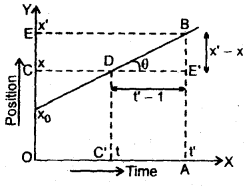
Let us consider the position-time graph of an object moving with uniform velocity represented by the line DB making angle 0 with the time axis. Let the coordinates of D and B be (x, t) and (x’, t’ ) respectively. Let BA and DC’ be perpendiculars drawn from B and D respectively on the time axis and BE and DC be perpendiculars on the y-axis from B and D.
Now BE’ = CE = x’ – x
and C’A = t’ – t = DE’
Then velocity = \(\frac{x^{\prime}-x}{t^{\prime}-t}=\frac{B E^{\prime}}{D E^{\prime}}\) = tanθ
So, velocity v = slope of position-time graph.
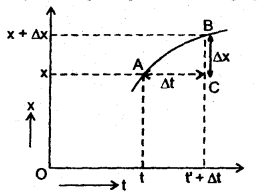
2. The position-time graph for a stationary object is a straight line parallel to the time axis. Here the slope of the curve is zero, which means the object is stationary as v = 0.
3. In the case of variable velocity the position time curve is not a straight line. In this case, the slope of the curve gives the average velocity

= slope or chord AB when Δt → 0,
then the slope of curve gives the instantaneous velocity.
Instantaneous velocity =
![]()
Thus the position-time graph gives information about velocity.
Question 3.
Derive relations :
(i) v = u + at
Answer:
v = u + at:
Derivation: By def. of acceleration, we know that

where v1 and v2 are the velocities of an object at times t1 and t2 respectively.
If v1 = u (initial velocity of the object) at t1 = 0
v2 = v (final velocity of the object) at t2 = t
Then (1) reduces to v = u + at
Hence derived.
(ii) v2 – u2 = 2as
Answer:
Derivation : We know that acceleration is given by a =\(\frac{v_{2}-v_{1}}{t_{2}-t_{1}}\) , where v1 and v2, t1 and t2 are as in (1).

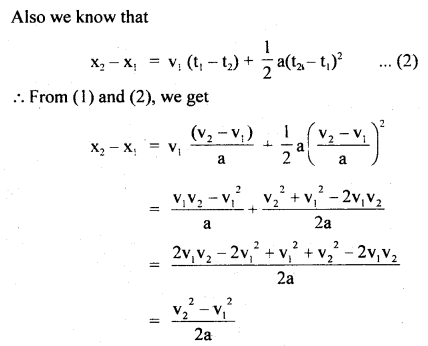
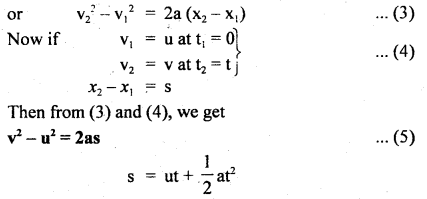
(iii) s = ut + \(\frac{1}{2}\) at2.
Answer:
Derivation:
Let x1, V1 = position and velocity of the object at time t1.
x2, v2 = position and velocity of the object at time t2.
a = uniform acceleration of the object.
Also Let vav = average velocity in t2 – t1 interval
∴ By definition

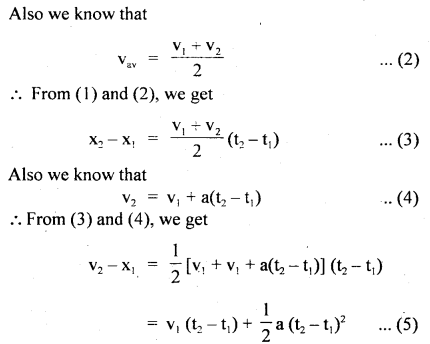
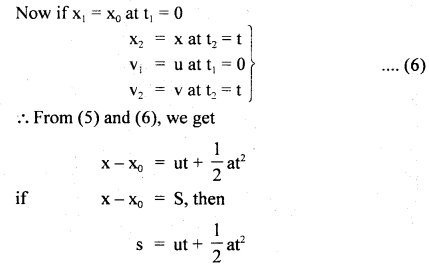
Hence derived.
Numerical Problems:
Question 1.
In a car race, car A takes a time t s less than car B and finishes the finishing point with a velocity v more than that of car B. Assuming that the cars start from rest and travel with constant acceleration a, and a respectively show that
v = t\(\sqrt{\mathbf{a}_{1} \mathbf{a}_{2}}\)
Answer:
Let v1, v2 be the finishing velocities of car A and car B respectively. Let t1, t2 be the finishing time-intervals for car A and car B respectively.
d = distance travelled by both cars.
∴ according to the statement
V = v1 – v2 ….(i)
t = t2 – t1 …(ii)
Let d = distance covered during a race by each car

Also using equation
s = ut + \(\frac{1}{2}\) at2, we get
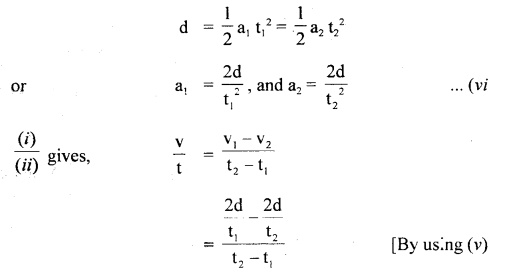
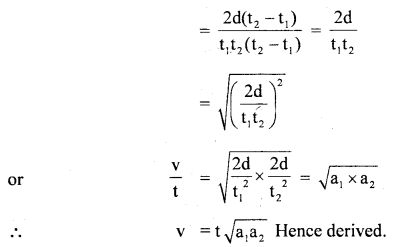
Question 2.
A car accelerates from rest at a constant rate a, for sometime after which it decelerates at a constant rate B to come to rest. If the total time elapsed is t s, then calculate
(a) maximum velocity reached.
(b) total distance travelled.
Answer:
The given situation is shown in fig. below:
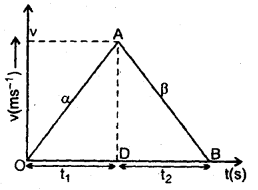
Let t1 and t2 be the times of acceleration and deceleration respectively of the car.
If t = total time of journey,
then t = t1 + t2 … (i)
Also let v = maximum velocity reached
(1) For accelerated motion, using equations, v = u + at, we get
v = 0 + αt1
or
v = αt1 … (ii)
(2) For decelerated motion,
here, u = v, final velocity is zero.
∴ 0 = v + (- β)t2
v = βt2 …(iii)
∴ From (ii) and (iii), we get
αt1 = βt2

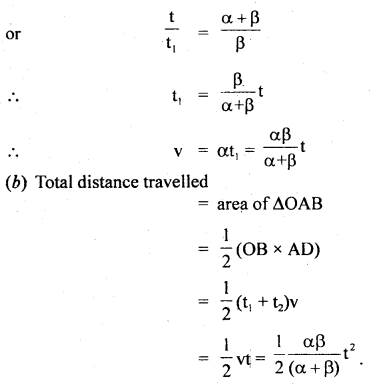
Question 3.
The driver of a train moving at a speed v1 sights another train at a distance d ahead of hint moving in the same direction with a slower speed v2. He applies brakes and gives a constant deacceleration ‘a’ to his train. Show that there will be no collision if
d > \(\frac{\left(\mathbf{v}_{1}-\mathbf{v}_{2}\right)^{2}}{2 \mathbf{a}}\)
Answer:
Let the collision be just avoided i.e. the rear train comes to rest after travelling a distance d with a declaration ‘a’.
the initial speed of 1 st train = v1
the initial speed of 2nd train = v2
If u = initial relative speed of 1 st w.r.t. 2nd train, then
u = v1 – v2
Final velocity of rear train v = 0
∴ using equations, v2 – u2 = 2as, we get
0 – (v1 – v2)2 = 2(- a) d (Here a = -a, s = d.)
d = \(\frac{\left(\mathbf{v}_{1}-\mathbf{v}_{2}\right)^{2}}{2 \mathbf{a}}\)
Thus there will be no collision, if
d > \(\frac{\left(\mathbf{v}_{1}-\mathbf{v}_{2}\right)^{2}}{2 \mathbf{a}}\)
Question 4.
A stone is dropped from the top of a tower and after one second, another stone is dropped from a point 20 m below the top. If both the stones reach the ground at the same time, calculate the height of the tower (take g = 10 mf2).
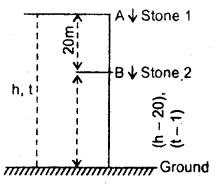
Answer:
The given situation is shown in fig.
Let t = time taken by the first stone to reach the ground
h = height of the tower
u1 = initial velocity O
∴ using equation
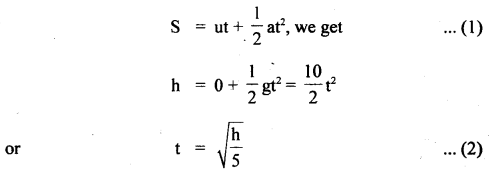
∴ t – 1 = Time taken by the second stone to reach the ground and
h – 20 = height of the point from where it is dropped l.
∴ u2 = initial velocity = 0
Thus using equation (1), we get

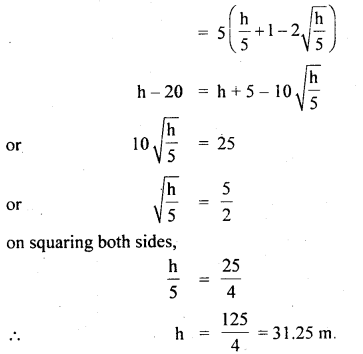
Question 5.
A body travels half of its total path in the last second of its fall from rest. Calculate the time and height of fall.
Answer:
Let h = height of fall
t = time of fall
a = g = 9.8ms-2
u = 0
∴ using equation,
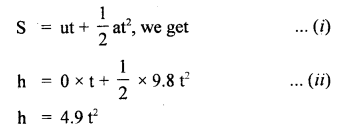
Also according to the statement first half i.e. \(\frac{h}{2}\) is covered in (t – 1)s.
∴ using (i), we get

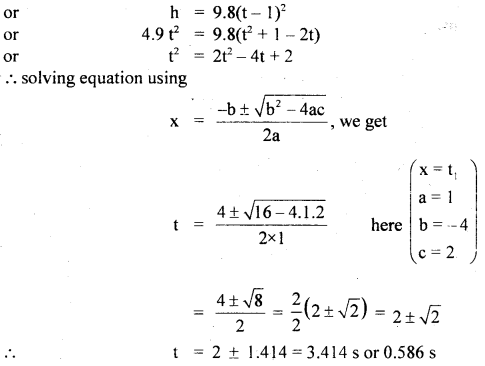
As last half of the journey takes 1 s, so t cannot be less than 1 s.
∴ t = 3.41s
∴ From(ii), h = 4.9 × (3.414)2
= 57.11 m
∴ h = 57.11, t = 3.414s.
Question 6.
A train moves from one station to another in 2h time. Its speed during the motion is shown in fig. Calculate
(a) the maximum acceleration during the journey.
(b) the distance covered during 0.75 to 1.00 h interval.
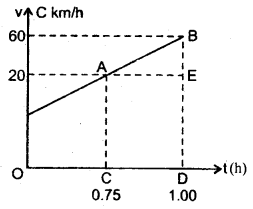
Answer:
(a) Maximum acceleration during the journey
= slope of AB part of the graph
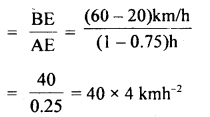
∴ acceleration = 160 kmh-2.
(b) Distance covered during the interval 0.75 to 1.00 h
= Area under the v -1 curve from 0.75 to 1.00
= Area of trapezium CABD
= Area of rectangle AEDC + area of AAEB
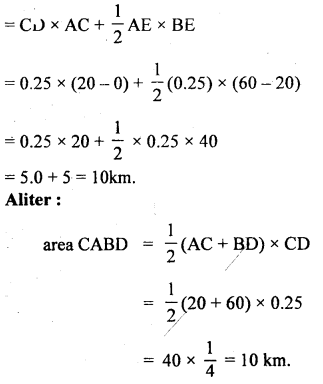
Question 7.
When the speed of the car is y, the minimum distance over which it can be stopped is z. If the speed of the car becomes v, then what will be the minimum distance over which it can be stopped?
Answer:
Case I:
Here, the initial velocity of car = v
The final velocity of car = 0
Let a = acceleration of car Distances covered before stopping = x
∴ Using the equation,
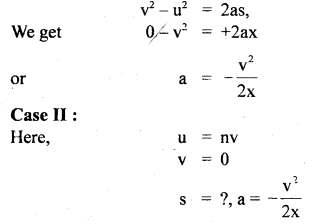
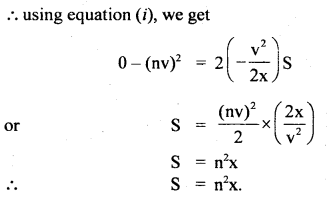
Question 8.
A body describes 10m in the third second and 12m in the Sth second with uniform acceleration. Find the distance covered by it in :
(a) next 3′ seconds and
(b) 8th second of its motion.
Answer:
Let the initial velocity of body = v
and let acceleration of body = a
Also, we know that distance covered during the nth second is given by
Snth =u + \(\frac{a}{2}\)(2n – 1)
∴ Distance travelled in 3rd and 5th second is:

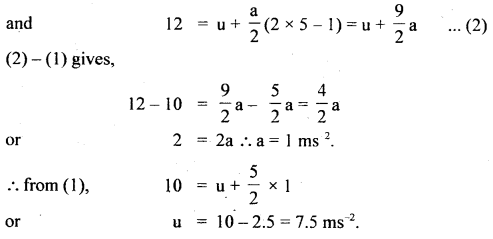
(a) using the equation, S = ut + at2, Let us find the distance covered by the body in 5s and 8 seconds.
Take u = 7.5,ms-1, a= I ms2
If x1 and x2 be the distances covered in 5s and 8s respectively.
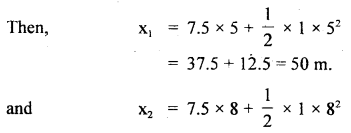
= 60 + 32 = 92 m
∴ Distance travelled by the body in next 3 seconds is given by
= x2 – x1
= 92 – 50 = 32 m
(b) The distance trave1ìdby the body in 8th second (x8) is given by
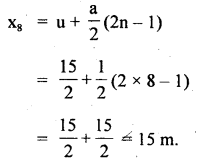
Question 9.
The velocity of an object (ms-1) moving along a straight line is given by
v = 10 + 3t2 …. (1)
Find (a) change in velocity in the interval when t = 2s and 5s.
(b) average acceleration in the same interval.
(c) instantaneous acceleration at t = 4s.
Answer:
Comparing equation (1), with the equation v = u + at, we find that u = 10ms-1,
(a) Now velocity of the object after 2 and 5 seconds is calculated as :
v = 10 + 3t2
putting t = 2, v = 10 + 3 × 22 = 10 + 3 × 4 = 22ms-1
putting t = 5, v = 10 + 3 × 52 = 10 + 3 × 25 = 85 ms-1.
∴ Change in velocity from 2s to 5 s
= 85 – 22 = 63 ms-1.
(b) We know that average acceleration in a given time interval is given by
aav = \(\frac{\Delta \mathrm{v}}{\Delta \mathrm{t}}\)
Thus aav in the interval 2s to 5 is given by
aav = \(\frac{85-22}{5-2}=\frac{63}{3}\) = 21 ms-2.
(c) We know that instantaneous acceleration is given by
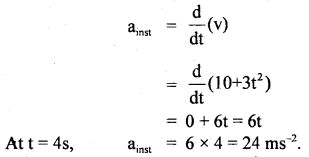
Question 10.
A car travels at a rate of 30 km h-1 for 5 minutes and then at 40 km h-1 for 10 minutes.
Find (i) the total distance covered by the car
(ii) the average speed of the car.
Answer:
v1 = 30 kmh-1 t1 = 5 min = \(\frac{5}{60}\) h = \(\frac{1}{12}\) h.
If S1 be the distance covered in 5 min., then
S1 = v1 t1 = 30 × \(\frac{1}{12}\) = \(\frac{5}{2}\) km = 2.5 km
Now v2 = 40 kmh-1, t2 = 10 minutes = \(\frac{1}{6}\) h
If S2 = distance covered in 10 min., then
S2 = v2 t2 = 40 × \(\frac{1}{6}\) = \(\frac{20}{3}\) km = 6.67 km.
(i) If S be the total distance, then
S = S1 + S2 = 2.5+ 6.67 = 9.17 km.
(ii) If vav be the average speed of the car,
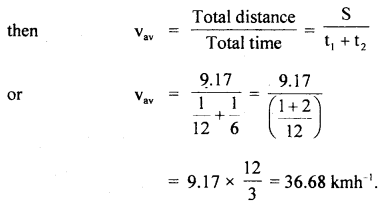
Question 11.
A particle covered half the distance with a velocity v0. The remaining half distance was covered with a velocity v1 for half the time and with velocity v2 for another half of the time. Find the mean speed of the particle averaged over the whole time of motion.
Answer:
Let S = total distance covered by the particle.
t1 = time taken to cover half the distance i.e. \(\frac{S}{2}\)
v0 = velocity of the particle
\(\frac{S}{2}\) = Distance covered with v0.
∴ using equation x = ut, we get

Now let 2t = time to cover the remaining distance \(\frac{S}{2}\).
If S1 = distance covered with v1 in time t.
S2 = distance covered with v2 in time t,
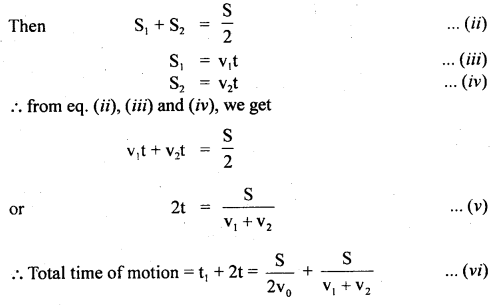
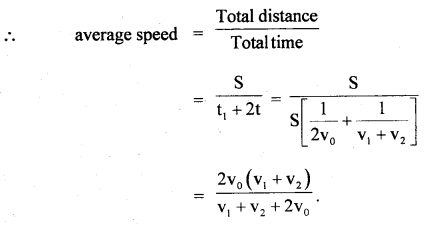
Question 12.
In a circus, a motorcyclist takes 4 rounds on the same track in the globe of radius r with a velocity 5r.
Find (i) total displacement
Answer:
radius of track = r, velocity v = 5r.
As the starting and endpoint in a circular track are the same, so the net displacement = 0
(ii) total distance covered
Answer:
Distance covered in one round = perimeter of the circular track of radius r
= 2π x r
∴ total distance covered in 4 rounds = 4 × 2πr = 8πr.
(iii) total time is taken by him.
Answer:
Let t = time taken by the motorcyclist in completing 4 rounds.
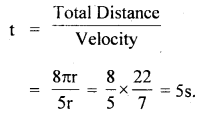
Question 13.
The displacement of a particle moving in one dimension under the action of a constant force is related to the time t by the equation t = \(\sqrt{x}\) + 3, where x is in metre and t is in second. Find the displacement of the particle when its velocity is zero.
Answer:
t = \(\sqrt{x}\) + 3
\(\sqrt{x}\) = t – 3 ….(1)
Squaring on both sides of equation (1), we get
x = (t – 3)2
= t2 + 9 – 6t …..(2)
If v be the velocity of the particle,
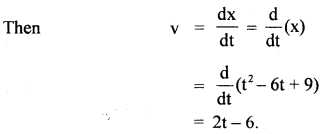

Question 14.
A car moving along a straight road with a speed of 144 km h-1 is brought to a stop within a distance of 200 m. Calculate its retardation and the time it takes to stop.
Answer:
Here, S = distance covered before topping = 200 m.
u = initial speed of car = 144 km h-1 = 144 × \(\frac{5}{18}\) ms-1 = 40 ms-1
v = its final speed = 0
Let a = retardation of the car =?
using the relation,
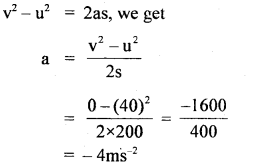
Also Let t = time taken ?
∴ using the relation, v = u + at, we get

Question 15.
A stone falls from the top of the tower in 8s. How much time will it take to cover the first quarter of the distance starting from the top?
Answer:
Here u = initial speed oftcie = 0
h = height of tower
t = time taken in falling by h = 8s
Let t1 = time taken to cover first quarter i.e. \(\frac{h}{4}\) = ?
a = g = acce. due to gravity
using the relation, S = ut + \(\frac{1}{2}\)at2
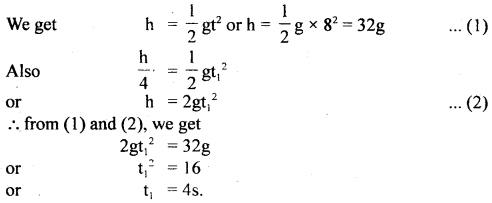
Question 16.
A ball is thrown vertically upwards with a velocity of 30 ms-1. If access. due to gravity is 10 ms-2, what will be the distance travelled by ¡tin the first and last second of upward motion?
Answer:
Here, u = initial velocity in the upward direction 30ms-1
Let after a time t, the ball stops i.e. v = 0
a = acce.= g = 10 ms-2
Let Snth be the distance covered by the ball in the last second i.e. nth second of its motion =7
∴ using the relation, v = u + at,

Let x1 be the distance covered by it in first second of its motion,
∴ using the relation, S = ut + \(\frac{1}{2}\) gt2, we get

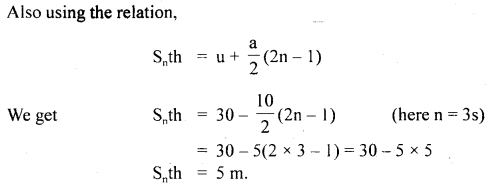
Question 17.
A rocket is fired vertically from the ground. It moves upwards with a constant acceleration of 10 ms-2 for the 30s after which the fuel is consumed. After what time from the instant of firing, the rocket will attain the maximum height? Take g = 10ms-2.
Answer:
Here, a = g = 10ms-2 for t = 30s
∴ u = 0 for first part of the motion
v = velocity attained by the rocket after 30s = ?
∴ using the relation,
v = u + at …(1)
we get v = 0 + 10 × 30
= 300 ms-1
for second part of motion,
u = v = 300 ms-1
v1 = final velocity = 0
Let t1 be the time of journey for this part of the motion,
∴ from equation (1), we get
0 = 300 – 10 × t1
Let T = total time of flight in which the rocket attains maximum height,
T = t + t1
= 30 + 30
= 60 second.
Question 18.
On a foggy day, two car drivers spot each other when they are just 80 m apart. They were travelling at 72 km h-1 and 60 km h-1 respectively. Both of them simultaneously apply brakes which retard both the cars at 5ms-2. Tell whether they will avert a collision or not?
Answer:
Here, let u, and u2 be the initial velocities of the two cars.
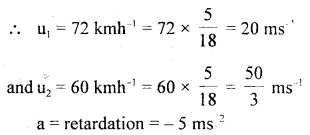
If S1 and S2 be the distances covered by the two cars before coming to rest (i.e. v = 0), then
using the relation,
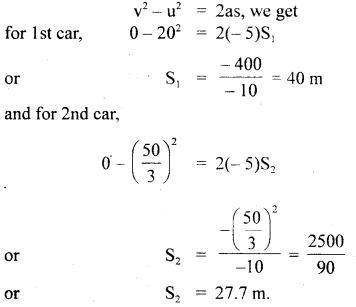
If S be the total distance covered by two cars before coming to rest, then
S = S1 + S2 = 40 + 27.7 = 67.7 m.
Also S1 = 80 m.
Now clearly the total distance covered by the cars before coming to rest is less than 80 m, so the collision will be averted.
Question 19.
A stone is dropped from a rising balloon at a height of 76 m above the ground and reaches the ground in 6s. What was the velocity of the balloon when the stone was dropped?
Answer:
Let u be the velocity of the balloon in an upward direction at the point
A = initial velocity of stone in an upward direction.
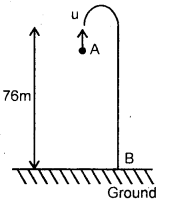
The stone rises to the top, comes to rest and then it starts coming back to the ground to hit B.
Let us take A as origin :
∴ Net vertical distance covered by the stone, y = – 76 m.
a = – g = – 9.8 ms-2
(Here y and acc. are taken as -ve because they are in a downward direction w.r.t. A)
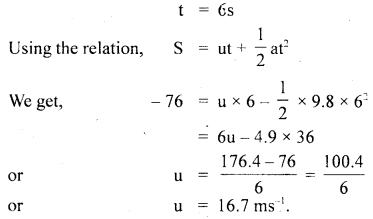
Question 20.
A car moves at a velocity of 2.24 km h-1 in the first minute, at 3.60 km h-1 in the second minute and at 5.18 km h-1 in the third minute. Calculate the average velocity in these three minutes.
Answer:
Let x1, x2 and x3 be the displacements of car in 1 st, 2nd and 3rd minutes respectively and let v1, v2 and v3 be the velocities of these time intervals,

∴ v1 = 2.24 kmh-1, v2 = 3.60 kmh-1, v3 = 5.18 kmh-1
time intervals = t1 = t2 = t3 = 1 minute = \(\frac{1}{60}\) h
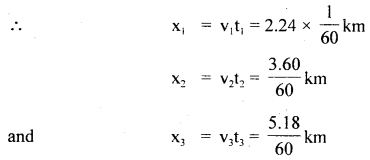
If x be the total displacement, then
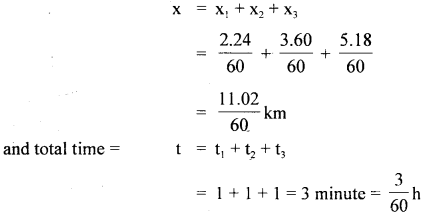
If v be the average velocity in these 3 minutes, then
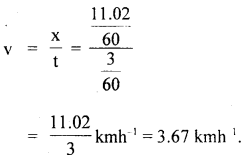
Question 21.
A man is walking due East at the rate of 3 km h-1. Rain appears to fall down vertically at the rate of 3 km h-1. Find the actual velocity and direction of the rainfall.
Answer:
Let a = angle made by the rainfall with the vertical Velocity of man represented by OA due East = 3 km h-1
As rain appears to fall vertically downward, so OB = 3 km h-1 represents the velocity of rain w.r.t. man. The actual velocity of rainfall is represented by OC and is given by
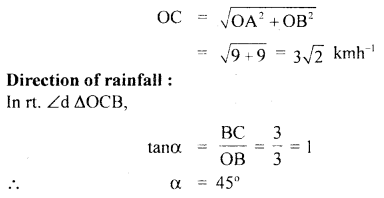
Thus the rain is actually falling at 3\(\sqrt{2}\) km h-1 at an angle of 45° west of the vertical.

Question 22.
A car starting from rest and moving with uniform acceleration possesses average velocities 5 ms-1, 10 ms-1 and 15 ms-1 in the first, second and third seconds. What is the total r distance covered by the car in these three seconds?
Answer:
Here, let v1, v2 and v3 be the average velocities of 1st, 2nd and 3rd secs, respectively.
∴ v1 = 5 ms-1, v2 = 10 ms-1, v3 = 15 ms-1
t1 = t2 = t3 = 1 s = time intervals
If x1, x2 and x3 be the distances covered in these seconds resp., then
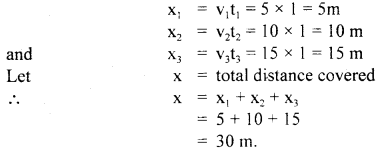
Question 23.
A person is running at a maximum speed of 3 ms-1 along the length of a train to catch hold of the door of a compartment. When he is just 2.5 m from the door, the train steams off with an acceleration of 1 ms-2. Find how long it takes him to catch the door?
Answer:

Here, let u1 = 3 m s-1, be the initial speed of man at point A.
For train x1 = 2.5 m = distance of the train from man.
u = 0, a = acceleration of train = 1 ms-2
Let C be their meeting point after a time t.
If BC = x, then usirig the relation,
S = ut + \(\frac{1}{2}\) at2, we get
For train, x = 0 + \(\frac{1}{2}\) × 1 × t2 = 0.5t2 … (1)
For man, using the relation,
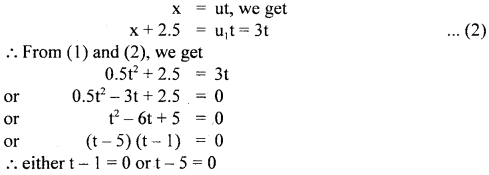
∴ t = 1, 5 i.e. he will catch the door first after Is and then after 5s.
t = 1s.
Question 24.
The displacement of a body along the x-axis changes according to the relation: x = 20 – 15t + 4t2, where x is in metres, t in seconds. Determine its position, velocity and acceleration at t = O.
Answer:
Here, x = 4t2 – 1 5t + 20 … (1)
v = \(\frac{\mathrm{d} \mathrm{x}}{\mathrm{dt}}\) = 4.2t – 15 = 8t – 15 …(2)
Also a = \(\frac{\mathrm{d} \mathrm{v}}{\mathrm{dt}}\) = 8
At t = 0, the position (x), velocity (y) and acceleration (a) are given by
x = 4.0 – 15 × 0 + 20 = 20 m
v = 8 × 0 – 15 = – 15ms-1
and a = 8 ms-2.
Question 25.
A body undergoes a uniformly accelerated motion. Its velocity after 5 seconds is 25 ems and after 8 seconds it is 34 cms’. Calculate the distance covered in the 12th second.
Answer:
Let u and a be the initial speed and acceleration of the body.
Let v1 and v2 be its velocities after 5s and 8s respectively
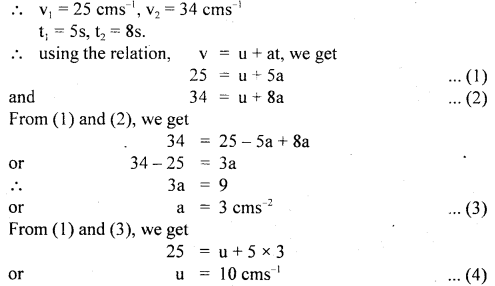
Let Snth be the distance covered in the 12th second.
Using the relation,

Value-Based Type:
Question 1.
On a two-lane road, there are hoardings hanged on the electric poles “Save Energy”.
If car a is travelling at a speed of 54 km h1 and car ‘B’ moves with 90 km h-1 from the opposite direction.
Now, answer these questions:
(a) Which values are depicted in the above problem? Write down the four ways by which the energy can be saved.
Answer:
Save energy to save our environment.
The four ways to save energy are as under :
(b) Write a slogan on “save energy”.
Answer:
Try your self
(c) Find the velocity of B with respect to A? Also, find the velocity of the ground with respect to B?
Solution:
VA = + 54 km h-1 = 15 ms-1
VB = 90 km h-1 = – 25 ms-1
(Takingthe velocity of car A positive N v and car B negative)
∴ Relative velocity of B with respect to A
= VB – VA = – 25 – 15 = – 40 ms-1
i.e the car Bappers to A to move with a speed 40 ms-1 from opposite direction.
Relative velocity of ground w.r.t B = 0 – VB = 0 – (- 25)
= 25 ms-1
Question 2.
A candle march was organised by an NGO. The theme of the candle march was “No use of non-biodegradable products”. The organizer made a semicircular track of radius R on which peoples have to run taking a poster in their hands. If Mahesh travelled from A to B in time t with constant speed, then answer the following:
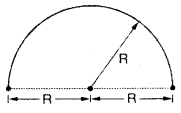
(i) Why should non-biodegradable products not be used? Justify your answer.
Answer:
Biodegradable products are reusable and cause less pollution. So, non-biodegradable products must be avoided.
(ii) Find the
(a) Displacement
Answer:
Displacement = minimum distance between initial and final point = AB = 2 R
(b) Average speed
Answer:
![]()
(c) Average velocity
Answer:
![]()
(d) Average acceleration
Answer:
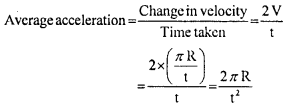
Question 3.
In sports day activities of a public school, the lines were drawn with chalk powder. Gagandcep an athlete runs a distance of 1500 m in the following manner, (i) Starting from rest, he accelerates himself uniformly at 2ms_1, till he covers a distance of 900 m. (ii) He then runs the remaining distance of 600 m at the uniform speed developed.
(i) Which value is depicted in the above problem?
Answer:
Importance of sports activities.
(ii) Do you think that sports activities are important in day-to-day life?
Answer:
Yes, sports activities are very much important in day-to-day life as
(a) It gives break from regular life
(b) It improves physical strength
(c) It relaxes our mind and body
(d) It helps to concentrate on other works
 im-90
im-90
(iii) Calculate the time taken by the athlete to cover the two parts of the distance covered.
Answer:
Let the athlete run from O to B Here, OB = 1500 m,
OA = 900 m, AB = 600 m
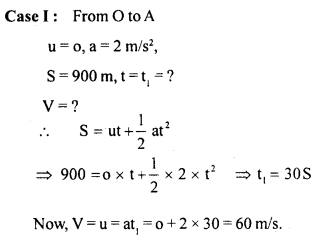
Case II : Taking motion of athelete from A to B u = 60 m/s, S = 600m, a = o (∵ Speed is uniform or constant)
t = t2 = ?
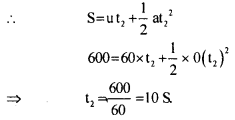
Question 4.
An old woman crossing the road was holding a money purse. She was not able to walk. A pickpocket snatches away her purse. A school student of class XI having seen this incident tries to help that old lady. He informs the polic^inspector who stands nearby. The inspector collects the money purse from the pickpocket and hands it over to the old lady.
(a) What value do you find in the school student?
Answer:
The student is sympathetic towards others, helping, and applies his presence of mind in solving the problems, knows how to use public services.
(b) Also the police inspector in a jeep is chasing the pickpocket on a straight road. The jeep is going at its maximum speed ‘v’. The pickpocket rides on the motorcycle of a waiting friend when the jeep is at a distance ‘d’ away. And the motorcycle starts with a constant acceleration ‘a’. Show that the pickpocket will be caught if v ≥ \(\sqrt{2ad}\).
Answer:
Let the police inspector catches the pickpocket after time t.
The distance covered by the pickpocket in this time interval is given by:
s = \(\frac{1}{2}\) at2
Distance travelled by the inspector (s1) = vt
the police inspector will catch the pickpocket if
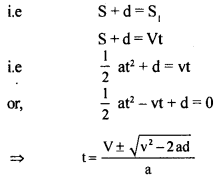
The police inspector will catch the bus if t is real i.e v2 ≥ 2ad or v ≥ \(\sqrt{2ad}\)
Hence, the minimum speed of the police inspector for catching the pickpocket is \(\sqrt{2ad}\) proved.
These Solutions are part of NCERT Solutions for Class 11 Physics. Here we have given NCERT Solutions for Class 11 Physics Chapter 4 Motion in a Plane
Question 1.
State, for each of the following physical quantities, if it is a scalar or a vector :
Volume, mass, speed, acceleration, density, number of moles, velocity, angular frequency, displacement, angular velocity.
Answer:
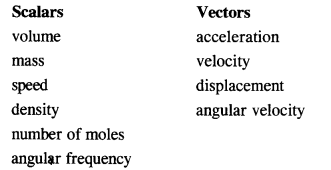
Average Velocity Calculator – Calculate Average Velocity.
Question 2.
Pick out the two scalar quantities in the following list:
Force, Angular momentum, work, current, linear momentum, electric field, average velocity, magnetic moment, reaction as per Newton’s third law, relative velocity.
Answer:
Work and Current.
Question 3.
Pick out the only vector quantity in the following list:
Temperature, pressure, impulse, time, power, total path length, energy, gravitational potential, coefficient of friction, charge.
Answer:
Impulse.
Question 4.
State with reasons, whether the following algebraic operations with scalar and vector physical quantities are meaningful:
Answer:
Question 5.
Read each statement below carefully and state with reasons, if it is true or false :
(a) The magnitude of a vector is always a scalar,
(b) each component of a vector is always a scalar,
(c) the total path length is always equal to the magnitude of the displacement vector of a particle
(d) the average speed of a particle (defined as total path length divided by the time taken to cover the path is either greater or equal to the magnitude of average velocity of the particle over the same interval of time,
(e) Three vectors not lying in a plane can never add up to give a null vector.
Answer:
(a) True, magnitude of the velocity of a body moving in a straight line may be equal to the speed of the body.
(b) False, each component of a vector is always a vector, not scalar.
(c) False, total path length can also be more than the magnitude of displacement vector of a particle. It is equal to the magnitude of displacement only if particle moves in one direction.
(d) True, average speed depends upon total path length which can be equal or more than the magnitude of displacement vector of the particle and average velocity depends upon the displacement vector. Thus average speed can be equal or greater than the magnitude of average velocity.
(e) True, three vectors not lying in a plane cannot form a closed triangle.
Question 6.
Establish the following vector inequalities geometrically or otherwise :
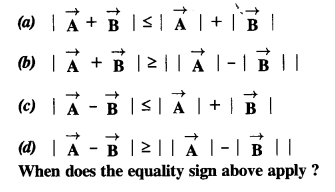
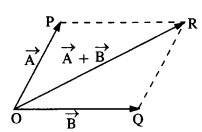
Answer:
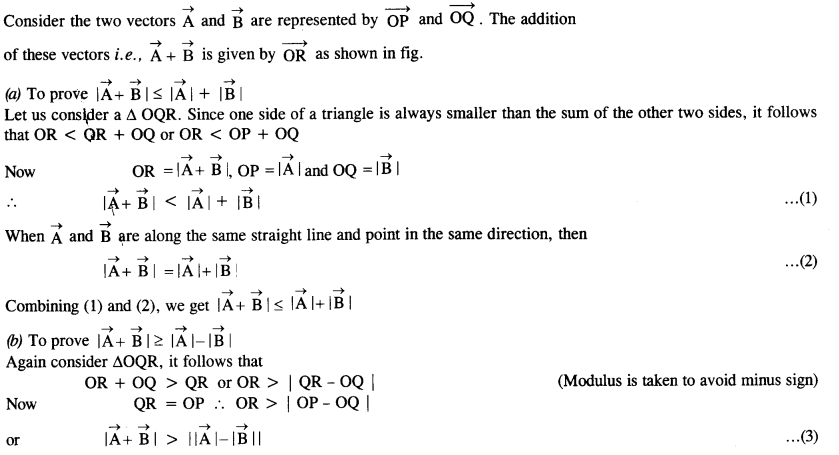

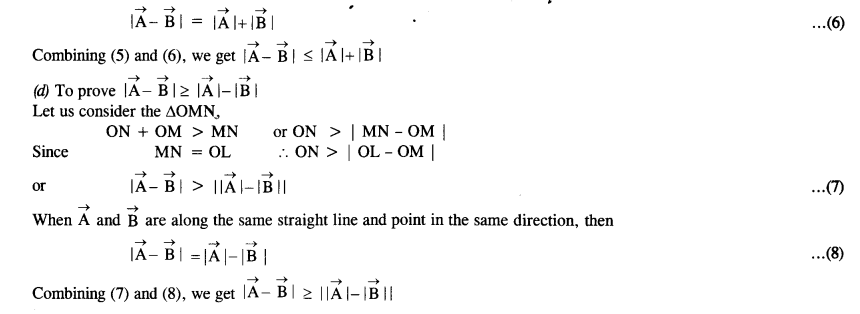
Question 7.

Answer:
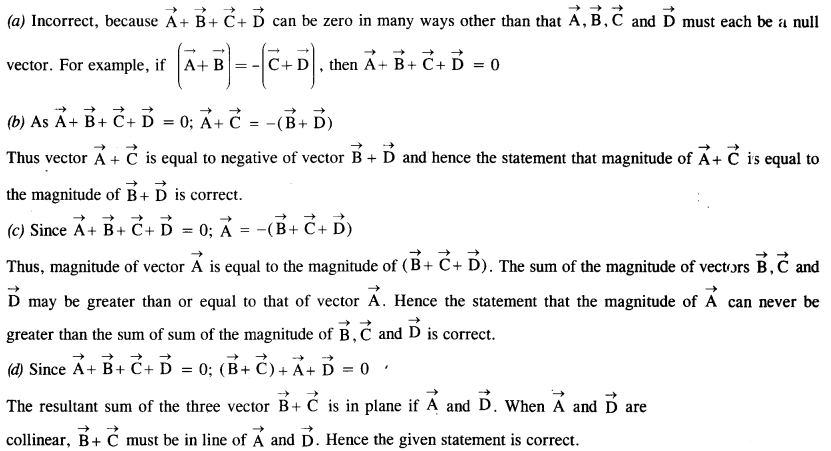
Question 8.
Three girls skating on a circular ice ground of radius 200 m start from a point P on the edge of the ground and reach a point Q diametrically opposite to P following different paths as shown in Fig. What is the magnitude of the displacement vector for each ? For which girl is this equal to the actual length of path skate ?
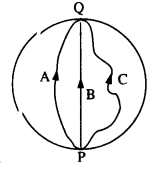
Answer:
(1) PQ = diameter = 2r = 2 x 200 = 400 m
Since displacement vector does not depend upon the actual path length and it is the shortest distance between initial and final position, so in the case of each girl the displacement is 400 m.
(2) Actual path length in the case of girl B is least e., equal to the displacement vector.
Question 9.
A cyclist starts from the center O of a circular park of radius 1 km, reaches the edge P of the park, then cycles along the circumference, and returns to the center along QO as shown in Fig. If the round trip takes 10 min, what is the
(a) net displacement,
(b) average velocity, and
(c) the average speed of the cyclist?
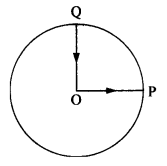
Answer:

Question 10.
On open ground, a motorist follows a track that turns to his left by an angle of 60° after every 500 m. Starting from a given turn, specify the displacement of the motorist at the third, sixth and eighth turn. Compare the magnitude of the displacement with the total path length covered by the motorist in each case.
Answer:
(1) The path Followed by the motorist will be a closed hexagonal path.
Suppose the motorist starts his journey from point O. He takes the turn at point C.
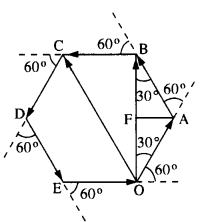
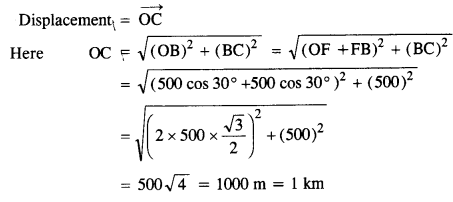
![]()
(2) The motorist will take the sixth turn at O.
Displacement is zero Path length is 3000 m i.e., 3 km
Ratio of magnitude of displacement and path length is zero.
(3) The motorist will take the 8th turn at B

Question 11.
A passenger arriving in a new town wishes to go from the station to a hotel located 10 km away on a straight road from the station. A dishonest cabman takes him along a circuitous path 23 km long and reaches the hotel in 28 min. What is
(a) the average speed of the taxi,
(b) the magnitude of average velocity? Are the two equal?
Answer:
Magnitude of displacement = 10 km
Total path length = 23 km
Time taken=28 min=\( \cfrac { 28 }{ 60 } \)= \( \cfrac { 7 }{ 15 } \) h

Question 12.
Rain is falling vertically with a speed of 30 ms-1. A woman rides a bicycle with a speed of 10 ms-1 in the north to south direction. What is the direction in which she should hold her umbrella?
Answer:

In order to protect herself from rain, the woman should hold her umbrella
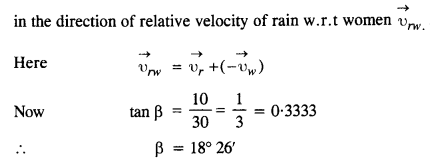
So a woman should hold her umbrella at an angle of 18°26′ with the vertical, towards the south.
Question 13.
A man can swim at a speed of 4 km/h in still water. How long does he take to cross a river 1km wide if the river flows steadily at 3 km/h and he makes his strokes normal to the river current? How far down the river does he go when he reaches the other bank?
Answer:
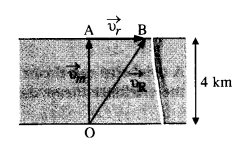

Question 14.
In harbour, the wind is blowing at the speed of 72 km/h, and the flag on the mast of a boat anchored in the harbour along the N-E direction. If the boat starts moving at a speed of 51 km/h to the north, what is the direction of the flag on the mast of the boat?
Answer:
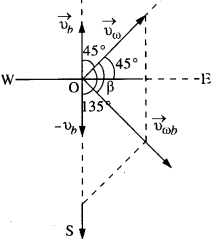
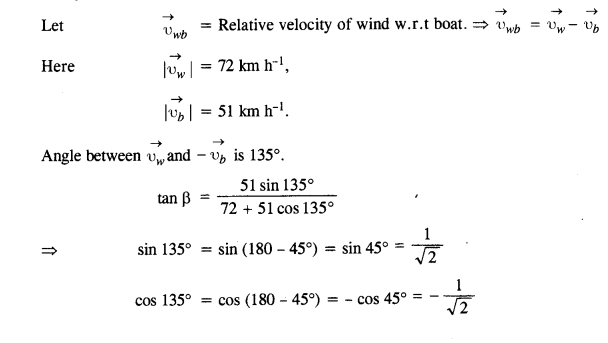

Question 15.
The ceiling of a long hall is 25 m high. What is the maximum horizontal distance that a ball thrown with a speed of 40 ms-1 can go without hitting the ceiling of the hall?
Answer:
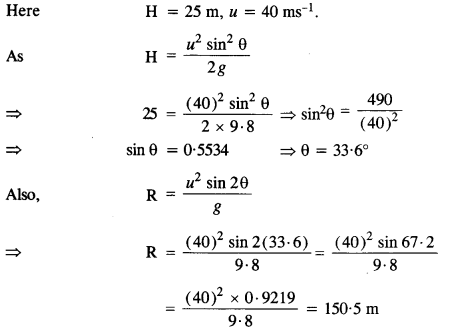
Question 16.
A cricketer can throw a ball to a maximum horizontal distance of 100 m. How much high above the ground can the cricketer throw the same ball?
Answer:
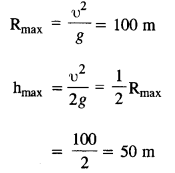
Question 17.
A stone tied to the end of a string 80 cm long is whirled in a horizontal circle with a constant speed. If the stone makes 14 revolutions in 25 s, what is the magnitude and direction of acceleration of the
stone ?
Answer:

Question 18.
An aircraft executes a horizontal loop of radius 1 km with a steady speed of 900 km/h. Compare its centripetal acceleration with the acceleration due to gravity.
Answer:
Here r = 1 km = 103 m, υ= 900 km h_1 = 900 x \( \cfrac { 5 }{ 18 } \)= 250 ms_1.

Question 19.
Read each statement below carefully and state, with reasons, if it is true or false :
(a) The net acceleration of a particle in circular motion is always along the radius of the circle towards the center.
(b) The velocity vector of a particle at a point is always along the tangent to the path of the particle at that point
(c) The acceleration vector of a particle in uniform circular motion averaged over one cycle is a null vector.
Answer:
(a) False, the net acceleration of a particle in circular motion is along the radius of the circle towards the center only in uniform circular motion.
(b) True
(c) True. (The direction of acceleration vector of a particle in uniform circular motion changes continuously. The sum of the vectors represented by a closed polygon taken in the same order is zero.)
Question 20.
The position of a particle is given by
\(\vec { r } \)=3.0 t \( \hat { i } \)-2.0 t2 \( \hat { i } \)+4.0\( \hat { k } \) m where t is in seconds and the coefficients have the proper units for r to be in meters.
(a) Find the v and a of the particle,
(b) What is the magnitude and direction of velocity of the particle at t = 3s?
Answer:
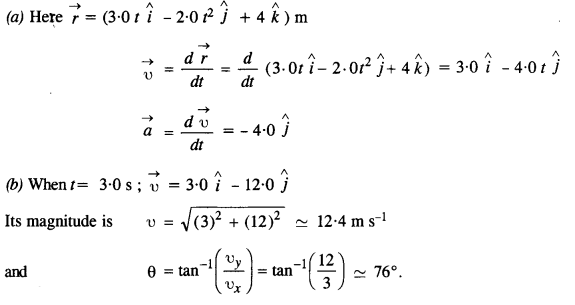
Question 21.
A particle starts from the origin at t = 0 with a velocity of 10.0 \( \hat { j } \) m/s and moves in the x-y plane with a constant acceleration of (8.0 \( \hat { i } \) +2.0 \( \hat { j } \))
ms-1
(a) At what time is the x-coordinate of the particle 16 m ? What is the y- coordinate of the particle at that time ?
(b) What is the speed of the particle at the time ?
Answer:
(a) The position of the particle is given by
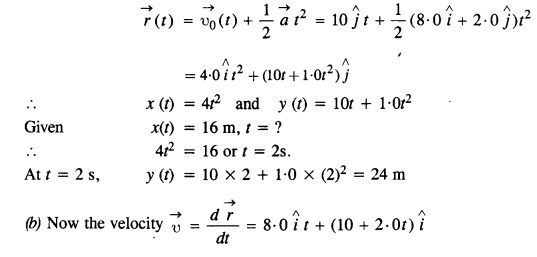

Question 22.
\( \hat { i } \) and \( \hat { j } \) are unit vectors along x-and y-axis respectively. What is the magnitude and direction of the vectors. \( \hat { i }+ { j }\) and \( \hat { i }-{ j }\) ? What are the components of a vector \( \vec { A }= \) \( \hat { 2i }+ { 3j }\) along the directions of \( \hat { i }+ { j }\) and \( \hat { i }-{ j }\)
Answer:
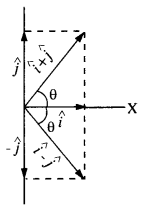

Question 23.
For any arbitrary motion in space, which of the following relations are true:
(a) υaverage (1/2) (υ (t1+υ t2)
(b) υaverage = [r (t1) – r (t2)]-(t2-t1)
(c) υ(t) = υ(0) + at
(d) r(t) = r(0) + υ(0) t + (1/2) at2
(e) υaverage =υ(t2) – υ (t1)]/(t2 – t1)
(The ‘average’ stands for an average of the quantity over the time interval t1 to t2)
Answer:
(b) and (e) is true. For arbitrary motion, acceleration may not be constant. Hence, (a), (c) and (d) are not true.
Question 24.
Read each statement below carefully and state, with reasons and examples, if it is true or false :
A scalar quantity is one that
Answer:
Question 25.
An aircraft is flying at a height of 3400 m above the ground. If the angle subtended at a ground observation point by the aircraft positions 10 s apart is 30°, what is the speed of the aircraft?
Answer:
Let A and B be the two positions of the aircraft separated by 10 s, then from the figure.
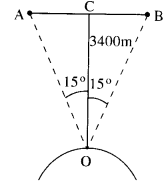
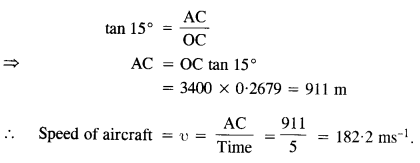
Question 26.
A vector has magnitude and direction. Does it have a location in space? Can it vary with time? Will two equal vectors’ \( \vec { A } and { B }\) at different locations in space necessarily have identical physical effects ? Give examples in support of your answer.
Answer:
A vector does not have any location in space. No, it can not vary with time provided its magnitude and direction are given. For Example, \( \vec { A }= \) \( \hat {2i }+{ 2j }+{ 5j }\) does not vary with time. Two equal vectors at different locations in space may have identical physical effects. For example, two bodies fall freely with the same acceleration at two positions if acceleration due to gravity at these two positions is equal.
Question 27.
A vector has both magnitude and direction. Does it mean that anything that has magnitude and direction is necessarily a vector? The rotation of a body can be specified by the direction of the axis of rotation, and the angle of rotation about the axis. Does that make any rotation a vector?
Answer:
No. Anything that has magnitude and direction is a vector only if it obeys the laws of vector addition. The finite rotation of a body about an axis is not a vector because finite rotation does not obey the commutation law.
Question 28.
Can you associate vectors with
Answer:
Question 29.
A bullet fired at an angle of 30° with the horizontal hits the ground 3 km away. By adjusting its angle of projection, can one hope to hit a target 5 km away? Assume the muzzle speed to the fixed, and neglect air resistance.
Answer:
Here R = 3 km = 3000 m, θ = 30°, g = 9.8 m s-2.
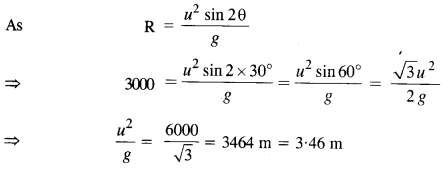
Maximum range of bullet =u2/g=3-46 m. Since the distance of the target (5 km) is greater than the maximum range of
Question 30.
A fighter plane flying horizontally at an altitude of 1.5 km with a speed of 720 km h-1 passes directly overhead an anti-craft gun. At what angle from the vertical should the gun be fired for the shell muzzle speed 600 m s-1 to hit the plane? At what maximum altitude should the pilot fly the plane to avoid being hit? Take g = 10 m s-2
Answer:
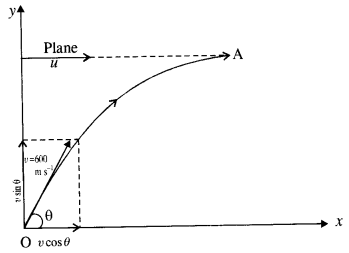
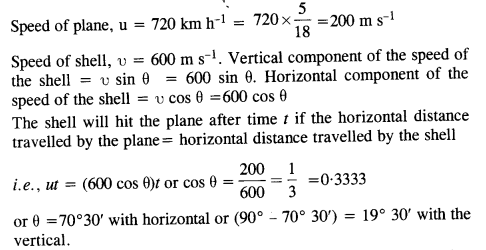

Question 31.
A cyclist is riding at a speed of 27 km/h. As he approaches a circular turn on the road of a radius of 80 m, he applies brakes and reduces his speed at the constant rate of 0.5 m/s every second. What is the magnitude and direction of the net acceleration of the cyclist on the circular turn?
Answer:
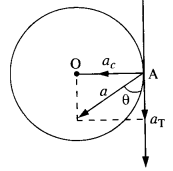
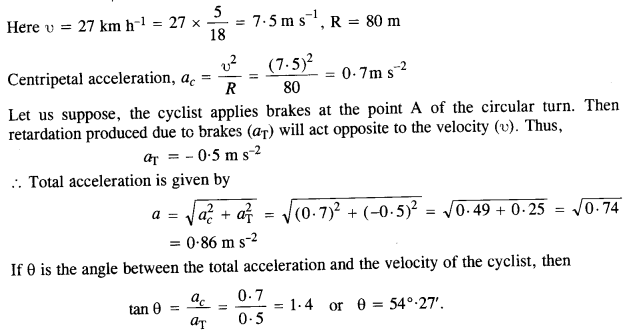
Question 32.
(a) Show that for a projectile, the angle between the velocity and the x-axis as a function of time is given by

(b) Show that the projection angle θo for a projectile launched from the origin is given by

where the symbols have their usual meaning.
Answer:
(a) Let a projectile fired at an angle θ with the x-axis.
As θ depends on t, θ(t), at any instant,
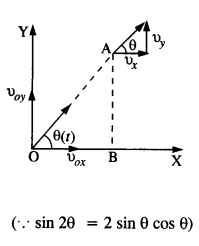
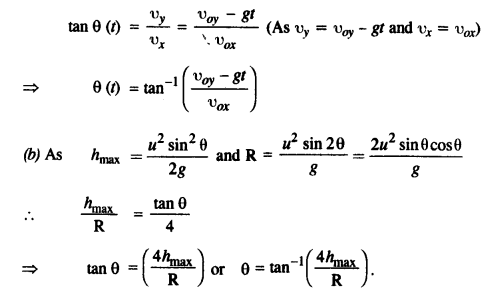
We hope the NCERT Solutions for Class 11 Physics Chapter 4 Motion in a Plane, helps you. If you have any query regarding NCERT Solutions for Class 11 Physics Chapter 4 Motion in a Plane, drop a comment below and we will get back to you at the earliest.
These Solutions are part of NCERT Solutions for Class 11 Biology. Here we have given NCERT Solutions for Class 11 Biology Chapter 17 Breathing and Exchange of Gases.
Question 1.
Define vital capacity. What is its significance?
Solution:
The maximum volume of air a person can breathe in after a forced expiration it is about 4000mL in a normal adult person. Vital capacity is higher in athletes and singers. Cigarette smokers have a lower vital capacity of the lungs. This includes ERC, TV, and IRV, or the maximum volume of air a person can breathe out after a forced inspiration.
Question 2.
State the volume of air remaining in the lungs after a normal breathing.
Solution:
The volume of air remaining in the lungs after normal respiration is called functional residual capacity. It includes ERV + RV = Expiratory reserve volume + residual volume
Question 3.
volume Diffusion of gases occurs in the alveolar region only and not in the other parts of the respiratory system. Why?
Solution:
Alveoli are the primary sites of the exchange of gases. The alveolar region is having enough pressure gradient to facilitate the diffusion of gases. Other regions of the respiratory system don’t have the required pressure gradient. Additionally, the membrane of alveoli is thin enough to facilitate the exchange of gases in a convenient manner.
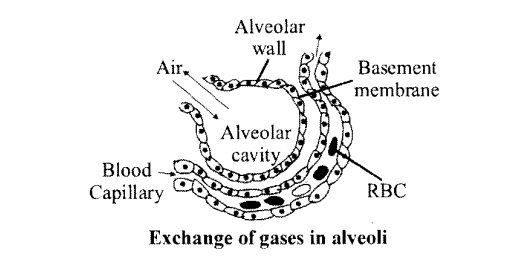
Question 4.
What are the major transport mechanisms for CO2? Explain.
Solution:
Transport of carbon dioxide: About 4 ml of carbon dioxide is transported by every 100 ml of blood.
C02 is transported in three forms in the blood.
(i) In the dissolved form in plasma about 7% of C02 dissolves in the plasma of blood, just as it gets dissolved in water.
(ii) As bicarbonates
Erythrocytes have a high concentration of the enzyme, carbonic anhydrase which catalyzes the following reactions;

About 70% of C02 is transported as bicarbonates.
(iii) As carbaminohaemoglobin
C02 combines with the globin part of haemoglobin and forms carbamino haemoglobin. About 23% of CO2 transported in this manner.
Question 5.
What will be the pO2 and pCO2 in the atmospheric air compared to those in the alveolar air?
(i) pO2 lesser, pCO2higher
(ii) pO2 higher, pCO2lesser
(iii) pO2 higher, pCO2 higher
(iv) pO2 lesser, pCO2lesser
Solution:
(ii) pO2 higher, pCO2 lesser
pO2 higher will create the pressure gradient to facilitate the movement of O2 from atmosphere to alveoli and pCO2 lesser will create the movement of CO2 from alveoli to atmosphere.
Question 6.
Explain the process of inspiration under normal conditions.
Solution:
The intake of air into the lungs is known as inspiration. Inspiration occurs when the pressure within the lungs is less than the atmospheric pressure. It is initiated by the contraction of the diaphragm which increases the volume of the thoracic chamber in the anteroposterior axis. The contraction of external intercostal muscles lifts up the ribs and the sternum causing an increase in the volume of the thoracic chamber in the dorsoventral axis. The overall increase in the thoracic volume causes a similar increase in pulmonary volume which decreases the intra-pulmonary pressure to less than the atmospheric pressure which forces the air from outside to move into the lungs.
Question 7.
How is respiration regulated?
Solution:
Question 8.
What is the effect of pC02 on oxygen transport?
Solution:
At low pC02, blood can carry the maximum amount of oxygen as oxyhemoglobin. At high pCO2, the affinity for oxygen decreases and oxyhaemoglobin dissociates to free oxygen.

So at high pC02, oxygen transport is inhibited.
Question 9.
What happens to the respiratory process in a man going up a hill?
Solution:
There is a fall of PO2 level at high altitudes. This lowers alveolar PO2 and consequently reduces the diffusion of oxygen from the alveolar air to the blood. So oxygenation of the blood is decreased progressively.
After some time, the affected person gets adjusted to the surroundings due to which the heart rate is accelerated, RBC count in the blood is increased, haemoglobin level and oxygen-carrying capacity are also increased.
Question 10.
What is the site of gaseous exchange in an insect?
Solution:
Insects have a complex system of intercommunicating air tubes called tracheae to enable them to exchange gases between the environment and the body cells (tracheal respiration).
Question 11.
Define oxygen dissociation curve. Can you suggest any reason for its sigmoidal pattern?
Solution:
The curve in which the percentage saturation of hemoglobin with O2 is plotted against the partial pressure of oxygen (PO2) is called the oxygen dissociation curve. At a PO2 of 100 mm Hg, 100 percent saturation of Hb takes place 90% saturation of Hb takes place even at a P02 of 60mm Hg. An I fall of PCX, from 100 to 60mm Hg will cause only 10% decrease in saturation of Hb. Hence the curve takes the shape of a sigmoid.
Question 12.
Have you heard about hypoxia? Try to gather information about it, and discuss it with your friends.
Solution:
Hypoxia is the condition in which there is a deficiency of oxygen at the tissue level.
Question 13.
Distinguish between
(a) IRV and ERV
(b) Inspiratory capacity and Expiratory capacity.
(c) Vital capacity and Total lung capacity.
Solution:
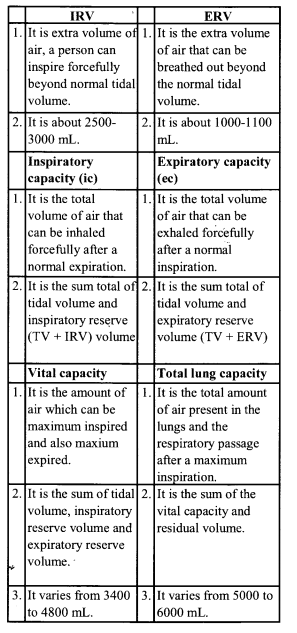
Question 14.
What is tidal volume? Find out the tidal volume (approximate value) for a healthy human in an hour.
Solution:
The volume of air inspired or expired/breath during normal respiration is approx. 500 ml., i.e., a healthy man can inspire or expire approximately 6000 to 8000 ml of air per minute.
VERY SHORT ANSWER QUESTIONS
Question 1.
Name the enzyme which catalyses the bicarbonate formation in RBCs.
Solution:
Enzyme carbonic anhydrase.
Question 2.
What is carbamino haemoglobin?
Solution:
It is a complex formed by the combination of carbon dioxide with the globin part of haemoglobin.
Question 3.
What is tidal volume?
Solution:
The volume of air inspired or expired with every normal breath during effortless respiration is called tidal volume.
Question 4.
What term is used for the volume of air left in the lungs even after the most powerful expiration?
Solution:
Residual volume.
Question 5.
Name the respiratory organ of
(a) Butterfly
(b) Frog larva.
Solution:
(i) Butterfly – trachea
(ii) Frog larva – gills.
Question 6.
What is the role of oxyhaemoglobin after releasing molecular oxygen in the tissue?
Solution:
Oxyhaemoglobin after releasing oxygen collects carbon dioxide from the tissue and form carbaminohaemoglobin.
Question 7.
What are the two factors that contribute to the dissociation of oxyhaemoglobin in the atrial blood to release’ molecular oxygen in active tissue?
Solution:
The two factors are :
(a) Lowp02
(b) HighpC02
Question 8.
Name the double-walled sac which covers the lungs in mammals.
Solution:
Pleura.
Question 9.
What prevents the collapsing of our trachea during breathing ?
Solution:
C-shaped cartilages at regular intervals.
Question 10.
Define inspiratory reserve volume.
Solution:
The extra volume of air that can be inspired beyond the normal tidal volume, is called inspiratory reserve volume.
Question 11.
Which part(s) of the brain control(s) breathing movements?
Solution:
Medulla and pons.
Question 12.
What is oxyhaemoglobin?
Solution:
Oxyhaemoglobin is a complex formed when oxygen combies with the Fe2+ part of haemoglobin.
Question 13.
How much of oxygen is transported by 100 ml of blood under normal physiological conditions?
Solution:
About 5 mL.
Question 14.
Write the chemical reaction catalysed by enzyme carbonic anhydrase.
Solution:
Carbonic anhydrase catalyses the following reaction:

Question 15.
How does penumotaxic centre alter the respiratory rate?
Solution:
Pneumotaxic centre can reduce the duration of inspiration and alter the respiratory rate.
Question 16.
What is the percentage of C02 transported as sodium bicarbonate?
Solution:
70% of C02 is transported as sodium bicarbonate.
Question 17.
What will happen if the human blood becomes acidic?
Solution:
Oxygen carrying capacity of haemoglobin will decrease.
SHORT ANSWER QUESTIONS
Question 1.
Write four conditions necessary to facilitates efficient gaseous exchange between human respiratory surface and the environment.
Solution:
Conditions for efficient gas exchange are as follows:
(a) The membrane should be thin.
(b) It should be highly vascularized.
(c) It should be highly permeable to gases.
(d) There should a partial pressure difference on both sides of lung.
Question 2.
Differentiate between pharynx and larynx.
Solution:
The main differences between the pharynx and larynx are as follows:

Question 3.
Why is hemoglobin called a conjugated protein? What happens to the molecule at a high and low partial pressure of oxygen?
Solution:
Hemoglobin: It is called conjugated protein because it consists of a basic protein globin and a non-protein heme.
The haemoglobin when exposed to the high partial pressure of oxygen combines with oxygen to form oxyhaemoglobin which carries 4 molecules of oxygen loosely bound to the four Fe2+ ions. When this oxyhaemoglobin reaches the tissues where there is low oxygen pressure oxyhaemoglobin dissociates into oxygen and deoxyhemoglobin.
Question 4.
Differentiate between inspiratory capacity and expiratory capacity.
Solution:
The differences between inspiratory and expiratory capacity are :
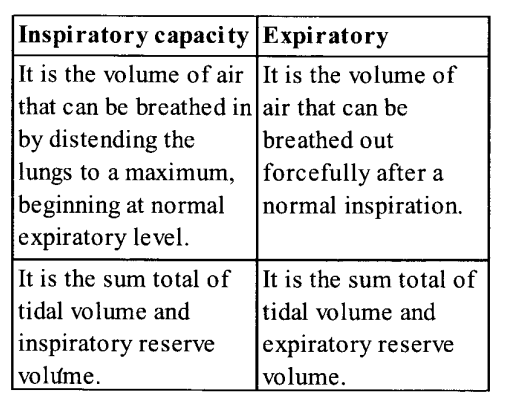
Question 5.
Diffusion of gases occurs in the alveolar region only and not in the other parts of the respiratory system. Why?
Solution:
The alveoli have very thin walls consisting of squamous epithelium. The alveolar wall is provided with an extensive network of blood capillaries; due to the intimate contact of the blood capillaries and alveolar wall, there is an exchange of gases taking place easily. In the other part the membrane/wall is not so thin to allow for diffusion.
Question 6.
What percentage of oxygen is transported by erythrocytes in the blood? What happens to the remaining?
Solution:
About 97% of the oxygen is transported by erythrocytes. The remaining 3% is transported in dissolved form in the plasma.
Question 7.
What is asthma? Explain.
Solution:
Asthma: It is the hypersensitivity of bronchioles to any foreign substance, characterized by the spasm of the smooth muscles of the walls of the bronchioles.
Question 8.
What is emphysema? What is its major cause?
Solution:
Emphysema: Emphysema is a chronic disorder is which alveolar walls are damaged and hence the surface area for exchange of. gases is reduced. It is caused mainly by cigarette smoking.
Question 9.
Draw a labelled diagram of a section of an alveolus with a pulmonary capillary.
Solution:

Question 10.
What will happen if the patient has been inhaling polluted air containing high content of CO?
Solution:
Hemoglobin has much more affinity about 250 times for CO than oxygen. It readily combines with CO to form the most stable compound called carboxyhemoglobin. It may be fatal for the patient.
Question 11.
What is pneumonia? What are its causes?
Solution:
Pneumonia is a respiratory disease in which oxygen has difficulty in diffusing through the flammed alveoli and the blood O2 may be drastically reduced and blood PCO2 remains normal. It is caused by streptococcus pneumonia. Its symptoms are trembling, pain in the chest, fever, cough, etc. It is mostly observed in children and old age.
LONG ANSWER QUESTIONS
Question 1.
What do you mean by occupational lung disease? Enumerate the prevention measure that should be adopted by a person likely to be exposed to substances that cause occupational diseases?
Solution:
Occupational lung disease as the name suggests it is the disease of lung due to the occupation of the human.
Cause: These are caused by harmful substances, such as gas fumes or dust, present in the environment where a person works. Silicosis and asbestoses are common examples, which occur due to chronic exposure of silica and asbestos dust in the mining industry.
Symptoms: It is characterized by the proliferation of fibrous connective tissue (fibrosis) of upper part of lung, causing inflammation.
Prevention: The occupational disease expresses symptoms after chronic exposure (i.e., 10-15 years or even more). Most of the occupational diseases including silicosis and asbestosis is are incurable. Therefore, the person which is exposed to such irritants should adopt preventive measures. These protective measures are as follows:
(i) Minimize the exposure of harmful dust at the workplace.
(ii) Workers should be informed about the harm of exposure to such dust.
(iii) Workers must have protective gear and clothing at the workplace.
(iv) health of the workers should be regularly checked up.
Question 2.
Explain the regulation of respiration by the nervous system.
Solution:
Regulation of respiratory rhythm
Question 3.
How does the exchange of respiratory gases take place in the alveoli or lungs?
Solution:
Gaseous exchange in alveoli:
Question 4.
How are inspiration and expiration take place in humans?
Solution:
The inflow (inspiration) and outflow (expiration) of air occur between the atmosphere and lungs by the expansion and contraction of lungs.
Inspiration: It is the process by which fresh air enters the lungs.
Expiration: It is a process by which foul air (CO2) is expelled out from the lungs.
We hope the NCERT Solutions for Class 11 Biology at Work Chapter 17 Breathing and Exchange of Gases, help you. If you have any query regarding NCERT Solutions for Class 11 Biology at Work Chapter 17 Breathing and Exchange of Gases, drop a comment below and we will get back to you at the earliest.
These Solutions are part of NCERT Solutions for Class 11 Biology. Here we have given NCERT Solutions for Class 11 Biology Chapter 19 Excretory Products and their Elimination.
Question 1.
Define Glomerular Filtration Rate (GFR).
Solution:
The amount of filtrate formed by the kidneys per minute is called glomerular filtration rater (GFR). GFR in a healthy individual is approximately 125ml/minute i.e. 180 lines per day.
Question 2.
Explain the autoregulatory mechanism of GFR.
Solution:
This mechanism in Kidney is present to regulate the glomerular filtrate rate.
Question 3.
Indicate whether the following statements are true or false :
(i) Micturition is carried out by a reflex.
(ii) ADH helps in water elimination, making the urine hypotonic.
(iii) Protein-free fluid is filtered from blood plasma into the Bowman’s capsule.
(iv) Henle’s loop plays an important role in concentrating the urine.
(v) Glucose is actively reabsorbed in the proximal convoluted tubule.
Solution:
(i) True
(ii) False
(iii) True
(iv) True
(v) True.
Question 4.
Give a brief account of the countercurrent mechanism.
Solution:
The loop of Henle and vcisa recta are responsible for concentrating the filtrate. The mechanism is called a counter-current mechanism. The flow of filtrate in limbs of Henle’s loop and vasa recta is in opposite direction so, forms a counter-current system. The proximity, as well as counter-current in them, maintains osmolarity increasing 300 mOsmolL-1 in the cortex and 1200 mOsmolL- 1 in inner medulla.
Question 5.
Describe the role of the liver, lungs and skin in excretion.
Solution:
Liver: This largest gland in our body, secretes bile-containing substances like bilirubin, biliverdin, cholesterol, degraded steroid hormones, vitamins and drugs. Most of these substances ultimately pass out along with digestive wastes.
Lungs: Lungs remove large amounts of CO2, about 18 liters/day, and also significant qualities of water every day.
Skin: The sweat and sebaceous glands in the skin eliminate certain substances through their secretions. Sweat is a watery fluid containing NaCI, small amounts of urea, lactic acid etc. Sebaceous glands eliminate certain substances like sterols, hydrocarbons, and waxes through sebum.
Question 6.
Explain micturition.
Solution:
Urine formed by the nephrons is ultimately carried to the urinary bladder where it is stored till a voluntary signal is given by the central nervous system (CNS). This signal is initiated by the stretching of the urinary bladder as it gets filled with urine. In response, the stretch receptors on the walls of the bladder send signals to the CNS. The CNS passes on motor messages to initiate the contraction of smooth muscles of the bladder and simultaneous relaxation of the urethral sphincter causing the release of urine. The process of release of urine is called micturition and the neural mechanisms causing it is called the micturition reflex.
An adult human excretes on average, 1.5 liters of urine per day. The urine formed is a light yellow colored watery fluid that is slightly acidic (pH-6.0) and has a characteristic odor. On average, 25-30 gm of urea is excreted out per day. Various conditions can affect the characteristics of urine. Analysis of urine helps in the clinical diagnosis of many metabolic disorders as well as malfunctioning of the kidneys. For example, the presence of glucose (Glycosuria) and ketone bodies (ketonuria) in urine are indicative of diabetes mellitus.
Question 7.
Match the items of Column I with those of column II.
Column I Column II
(a) Ammonotelism (i) Birds
(b) Bowman’s capsule (ii) Water reabsorption
(c) Micturition (iii) Bony fish
(d) Uricotelism (iv) Urinary bladder
(e) ADH (v) Renal tubule
Solution:
(a) – (iii) Bony fish
(b) – (v) Renal tubule
(c) – (iv) Urinary bladder
(d) – (i) Birds
(e) – (ii) Water reabsorption
Question 8.
What is meant by the term osmoregulation?
Solution:
Osmoregulation is the mechanism of maintaining water, blood, body fluid, and ionic (salt) balance in the body.
Question 9.
Terrestrial animals are generally either ureotelic or uricotelic, not ammonotelic, why?
Solution:
Land animals have an integument that is impervious to gas exchange. Ammonia is highly toxic and it has to be eliminated as rapidly as it is formed. It requires a large volume of water for its elimination. They do not have access to such a large volume of water needed for the elimination of ammonia. So, they are either ureotelic or uricotelic.
Question 10.
What is the significance of the juxtaglomerular apparatus (JGA) in kidney function?
Solution:
The JGA plays an important role in the regulation of kidney function. A fall in glomerular blood flow / glomerular blood pressure / GFR can activate the JG cells to release renin which converts angiotensinogen in the blood to angiotensin I and further to angiotensin II. Angiotensin II, being a powerful vasoconstrictor, increases the glomerular blood pressure and thereby GFR. It also activates the adrenal cortex to release Aldosterone. Aldosterone causes reabsorption of Na+ and water from the distal parts of the tubule. This also leads to an increase in blood pressure and GFR. This mechanism is known as the Renin-Angiotensin mechanism.
Question 11.
Name the following:
Solution:
Question 12.
Fill in the gaps:
Solution:
VERY SHORT ANSWER QUESTIONS
Question 1.
Name the nitrogenous waste excreted by larval and adult stage of frog respectively.
Solution:
Larval stage – ammonia, Adult stage – urea.
Question 2.
In which organ ammonia is converted to urea?
Solution:
Liver.
Question 3.
Define ammonotelism.
Solution:
The excretion of ammonia is called ammonotelism.
Question 4.
What is hemodialysis?
Solution:
The process of removal of excess urea from the blood of a patient (normally suffering from uremia) using an artificial kidney is known as hemodialysis
Question 5.
Define ketonuria.
Solution:
The presence of high ketone bodies in the urine is called ketonuria.
Question 6.
What are the columns of Bertini?
Solution:
These are the extension of the renal cortex between the medullary pyramids as renal columns.
Question 7.
In which part of the nephron does filtration take place?
Solution:
Bowman’s Capsule/Renal Corpuscle
Question 8.
What difference is observed in the ascending and descending limbs of Henle’s loop with g reference to permeability to water?
Solution:
Ascending limb is impermeable to water and permeable to solutes.
Descending limb is permeable to water and impermeable to solutes.
Question 9.
Name the body part through which ammonia is eliminated in a bony fish.
Solution:
Gill membranes.
Question 10.
What is vasa recta ?
Solution:
The U-shaped peritubular capillary that runs parallel to the Henle’s loop is called vasa recta.
Question 11.
What is the driving force for glomerular filtration?
Solution:
The driving force for filtration is the blood pressure in the glomerular capillaries.
Question 12.
How are the filtration slits formed?
Solution:
The podocytes are arranged in an intricate manner so as to leave some minute spaces called filtration slits.
Question 13.
Why is glomerular filtration also called as ultrafiltration?
Solution:
Blood is filtered so finely through these membranes, that almost all the constituents of the plasma except the proteins pass onto the lumen of the bowman’s capsule. Therefore, it is considered as a process of ultrafiltration.
Question 14.
Name the mechanism that acts as a check for the Renin-angiotensin mechanism.
Solution:
Arterial Natriuretic Factor (ANF) Mechanism.
Question 15.
What is uremia?
Solution:
Uremia is a condition of excess accumulation of urea in the blood caused by the malfunctioning ofkidneys.
Question 16.
What term is given to the inflammation of glomerulus in nephron?
Solution:
Glomerulonephritis.
Question 17.
Which limb of loop of Henle is impermeable to water?
Solution:
Bowman’s capsule and glomerulus are collectively called malpighian body.
Question 18.
What is afferent arteriole?
Solution:
Blood vessels leading to glomerulus is called afferent arteriole.
Question 19.
Which hormone promotes the reabsorption of water from glomerular filtrate?
Solution:
Vasopressin promotes reabsorption of water from the glomerular filtrate.
SHORT ANSWER QUESTIONS
Question 1.
How does the proximal convoluted tubule of the nephron contribute to homeostasis?
Solution:
All essential nutrients and 70-80 percent of electrolytes and water are reabsorbed by the PCT segment. So it helps to maintain the pH and ionic balance of the body fluids by selective secretion of hydrogen ions, ammonia and potassium ions into the filtrate and by absorption of HCO3-” from it.
Question 2.
What are the functions of nephridia? Name an animal having protonephridia
Solution:
Nephridia help to eliminate nitrogenous wastes and maintain a fluid and ionic balance. Protonephridia are present in Amphioxus, Rotifers, Planaria, etc.
Question 3.
Kidney do not play a major role in excretion in ammonotelic animals. Justify.
Solution:
Ammonia is readily soluble in water and diffuses across the body surface.
In fish, it is excreted as ammonium ions through gill surface. So kidneys do not have any significant role in the elimination of ammonia.
Question 4.
What are the functions of ADH?
Solution:
(i) ADH facilites water absorption from the distal tubule.
(ii) It also affect kidney function by its constrictor effects also on blood vessels.
Question 5.
What is the ultimate method of correcting acute renal failure? Describe.
Solution:
Kidney transplantation is the ultimate method in the correction of acute renal failures (kidney failure). A functioning kidney is used in transplantation from a donor, preferably a close relative, to minimize its chances of rejection by the immune system of the host.
Question 6.
Mention the role of DCT in urine formation.
Solution:
Distal convoluted tubule plays the following roles:
Question 7.
Why do persons suffering from very low blood pressure pass no urine?
Solution:
The blood passes into the glomerulus under high pressure during glomerular filtration. If blood pressure is less then it results in the failure of the ultrafiltration process in the glomerulus and hence, no urine formation occurs.
Question 8.
Name the passage in sequence through which urine passes from kidneys to the outside in humans. How is urine prevented from flowing back into the ureters?
Solution:
Kidneys → ureters → urinary bladder → urethra
Urine is prevented from flowing back into the ureters because the terminal part of each ureter passes obliquely through the bladder wall.
Question 9.
(a) The two human kidneys do not occur at the same level-explain.
(b) Why are Kidneys called retro-peritoneal?
Solution:
(a) Left kidney is slightly longer, narrower, median, and lies at a level 1.25 cm higher than the right kidney. The right kidney is lower in position due to the presence of the right lobe of the liver.
(b) Retroperitoneal. It is space that lies between the peritoneum and vertebral column, Kidneys occur in this space so that they are lined by peritoneum only on the ventral side.
Question 10.
Differentiate between Cortical Nephron and Juxtamedullary Nephron.
Solution:
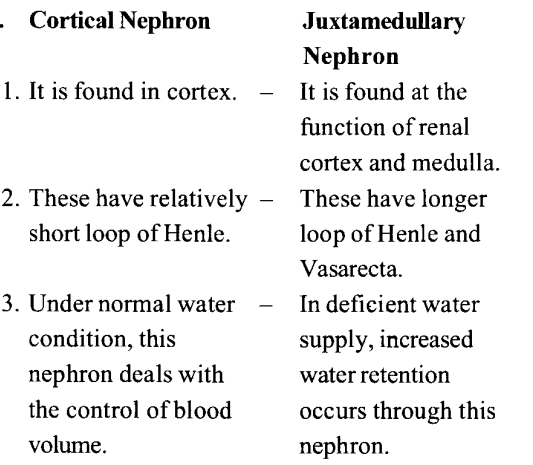
Question 11.
What is the chemical composition of human urine?
Solution:
Human urine is transparent, yellowish in colour and variable in chemical composition. It
consists primarily of water (95 %), with organic solutes including urea (2.6%), creatinine, uric acid, and trace amounts of enzymes, carbohydrates, hormones, fatty acids, pigments, and mucins, and inorganic ions such as Na+, K+, Cl– Mg2+, Ca2+, and phosphates.
Question 12.
What is Erythropoietin? What is its function?
Solution:
Erythropoietin is a glycoprotein hormone that controls erythropoiesis, or the formation of red blood cells. It acts as a cytokine (proteinsignaling molecule) for RBC precursor in bone marrow. It is produced by enterstitial fibroblasts in the kidney in close association with peritubular capillary and tubular epithelial tubule.
Long ANSWER QUESTIONS
Question 1.
Describe the structure of the kidney.
Solution:
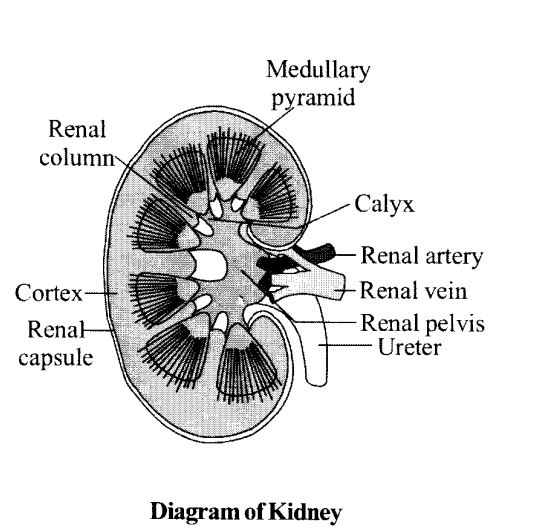
Question 2.
Describe the role of organs other than the kidney in the process of excretion in human beings.
Solution:
Question 3.
Describe the structure of nephron.
Solution:
Structure of nephron
A nephron has two parts-the glomerulus and the renal tubule
(i) Glomerulus: It is a tuft of capillaries formed by the afferent arteriole, which is a fine branch of the renal artery.
(ii) Renal tubule has three-part
(a) proximal convoluted tubule
(b) loop of Henle
(c) distal convoluted tubule
(a) Proximal convoluted tubule –
(b) Loop of Henle – It arises from the end of the proximal convoluted tubule and ends at the starting of the distal tubule.
It is hairpin-like, with a descending limb (that extends into the medulla) and an ascending limb, that crosses back to the cortex.
(c) Distal convoluted tubule –
Question 4.
Describe the process of hemodialysis.
Solution:
Haemodialysis:
We hope the NCERT Exemplar Solutions for Class 11 Biology at Work Chapter 19 Excretory Products and their Elimination, help you. If you have any query regarding NCERT Exemplar Solutions for Class 11 Biology at Work Chapter 19 Excretory Products and their Elimination, drop a comment below and we will get back to you at the earliest.
Here we are providing NCERT Solutions for Class 11 English Hornbill Chapter 2 We’re Not Afraid to Die. Students can get Class 11 English We’re Not Afraid to Die NCERT Solutions, Questions and Answers designed by subject expert teachers.
We’re Not Afraid to Die… If We Can All Be Together Understanding the text
Question 1.
List the steps taken by the captain
(i) to protect the ship when rough weather began.
(ii) to check the flooding of the water in the ship.
Answer:
(i) to protect the ship when rough weather began.
Answer:
The captain slowed the boat down, dropped the storm jib and lashed a heavy mooring rope in a loop across the stem. Then they double-lashed everything, went through their life raft drill, attached “lifelines, donned oilskins and life jackets and waited.”
(ii) to check the flooding of the water in the ship.
Answer:
As the water started accumulating in the ship, the captain did not dare to abandon the wheel to examine the waterlogging. When Mary informed him that the decks were smashed and the boat was full of water, he gave the wheel to Mary and made it to the hatch. Larry and Herb were pumping out the water frantically. He found a hammer, screws and canvas, and walked back to the deck with difficulty.
He made some repairs. He stretched the canvas and secured that the waterproof hatch covers across the gaping holes. Some water continued to stream below, but most of it was now being deflected over the side. But soon the hand pumps started to block up with the debris floating around the cabins and the electric pump short-circuited. He found the two spare hand pumps had been overboard. Then he took the electric pump and connected it to an out-pipe and managed to pump out the water.
Question 2.
Describe the mental condition of the voyagers on 4 and 5 January.
Answer:
After battling with the waves and continuously pumping out water for thirty-six hours, on 4 January, the voyagers managed to pump out almost all the water that had accumulated and had to keep pace with the water that was still coming in. Then they hoisted the storm jib and sailed towards where they thought the two islands were. It was then that they were relieved and ate their first meal in almost two days. But much to their disappointment, at 4 p.m. black clouds gathered behind them.
The wind was back to 40 knots and the sea was getting higher. The weather continued to get worse throughout the night, and by dawn on 5 January, the situation was again distressing. The author tried to comfort the children, who seemed to be resigned to their fate. He was resolute to fight the sea but by the evening, Mary and he sat together holding hands, as the water seeped in through the broken planks. Both of them felt that their end was very near.
Question 3.
Describe the shifts in the narration of the events as indicated in the three sections of the text. Give a subtitle to each section.
Answer:
The text has been divided into three sections. The narration shifts as the events unfold. The first section deals with the narrator’s desire to go sailing around the world, the preparations they made, the onset of the journey and the coming storm. In this section, the narrator sums up more than sixteen years of preparations and the first 3,500 kilometres of their journey in a few paragraphs.
The second section describes the storm and the damage caused to the boat by the storm. The narrator describes in detail the events of 2 January when their ship was buffeted by the storm. He mainly deals with the action taken to avert disaster. In the third section, the narrator steers the ship to safety at He Amsterdam.
In this section, he describes the events of two days and focuses on the emotions of the members of the family as the near-tragedy drew them closer together. The 1 st section can be subtitled .The sea voyage and its challenges, the 2nd – Damages caused by the storm, and the 3rd- Finding lie Amsterdam.
We’re Not Afraid to Die… If We Can All Be Together Talking about the text
Discuss the following questions with your partner.
Question 1.
What difference did you notice between the reaction of the adults and the children when faced with danger?
Answer:
When the adults were faced with danger, they were anxious and sought out ways of battling it. For instance, when they faced rough weather for the first time, they fastened everything, went through their life raff drill, attached lifelines, put on oilskins and life jackets. As the ship flooded with water, Mary panicked and the narrator put her at the wheel, struggled with tools till the ship was waterproof and the water had been bailed out.
They assessed the situation, tried to adopt the best possible strategy for coping with the situation but were often dejected. When the narrator was thrown overboard, he accepted death as inevitable. Similarly, when the motion of the ship brought more and more water in through the broken planks, Mary and the narrator sat holding hands as both felt the end was very near.
On the other hand, Sue hurt herself. Her head had swollen a lot, she had two huge black eyes, and a deep cut on her arm but this did not worry her. The situation worsened and when the author tried to comfort the children on 5 January, Jon said that they were not afraid of dying if the family could be together. due, who was injured, moved up to him and gave him a card she had made. It was a message to hope for the best. The probable reason for the difference in reaction is that the children did not realise the gravity of the situation, like the adults, or that they do not cling on to life like adults.
Question 2.
How does the story suggest that optimism helps to endure “the direst stress”?
Answer:
It was the sheer optimism of the narrator and the two men in the crew, Larry and Herb, that helped them carry on in the face of life-threatening dangers. They celebrated Christmas despite the gales. When the storm struck and the narrator was flung overboard, he did not give up hope but got back to the ship with his ribs cracked and his mouth filled with blood and broken teeth. He took the wheel and fought water that was getting into the ship.
This shows, they were not willing to give in to danger but were ready to battle it. They faced the extremely cold night, struggling to pump out water, find direction and also work the radio. With no response to their desperate calls for help because they were in a distant comer of the world, they were still optimistic about finding lie Amsterdam and steered the ship towards that direction. Their optimism paid off” and they came out of a stressful situation.
Question 3.
What lessons do we learn from such hazardous experiences when we are face-to-face with death?
Answer:
One learns to be:
Question 4.
Why do you think people undertake such adventurous expeditions in spite of the risks involved?
Answer:
A human being’s life has become monotonous and mechanical. This deprives us of two important ingredients of happiness spontaneity and variety. Mechanical regularity produces discontentment as it is devoid of joy. Spontaneity and variety are needs of our instinctive nature that can only be satisfied by such adventures. Adventurous expeditions and other high level sports or activities break the monotony of modem life and provide opportunities to test our survival skills.
We’re Not Afraid to Die… If We Can All Be Together Thinking about language
Question 1.
We have come across words like ‘gale’ and ‘storm’ in the account. Here are two more words for ‘storm’: typhoon, cyclone. How many words does your language have for ‘storm’?
(Answers will vary).
Question 2.
Here are the terms for different kinds of vessels: yacht, boat, canoe, ship, steamer, schooner. Think of similar terms in your language.
(Answers will vary).
Question 3.
‘Catamaran’ is a kind of a boat. Do you know which Indian language this word is derived from? Check the dictionary.
Answer:
The word was coined in the early seventeenth century. It is derived from the Tamil word kattumaram, that means ‘tied wood’. Catamaran is a name applied to any craft having twin hulls. Originally, it denoted a form of Sailing and paddling raft employed on the coasts of India. In a catamaran, two similar or identical hulls are joined parallel to each other at some distance apart by beams or a platform.
Such crafts were highly developed in the Hawaiian, Marquesas, Tuamotu islands and Tahiti. Some of these crafts had hulls of unequal length. In recent years, the sailing catamaran has again become popular. The advantage of the catamaran is that great stability can be combined with lightness and low water resistance. In recent years, a triple-hull craft called a trimaran has also been developed.
Question 4.
Have you heard any boatmen’s songs? What kind of emotions do these songs usually express?
Answer:
Some famous boatmen songs include “Drunken Sailor” which describes a group of boatmen pondering over what to do with a drunken sailor early in the morning. “A Hundred Years Ago” pokes fun at the simplicity and foolishness of people that lived a hundred years ago, who thought pigs could fly and the moon was made of cheese. Both these songs are part of the genre referred to as shanty which are songs sung by boatman to amuse themselves during their work. Therefore the tone and lyrics are usually light hearted and amusing.
(Answers will vary).
We’re Not Afraid to Die… If We Can All Be Together Working with words
Question 1.
The following words used in the text as ship terminology are also commonly used in another sense. In what contexts would you use the other meaning?
knot ,stern, boom, hatch, anchor
I. Knot:
II. Stern:
III. Boom (verb)
(noun)
IV. Hatch
V. Anchor (noun)
(Verb)
Question 2.
The following three compound words end in -ship. What does each of them mean? airship flagship lightship
Answer:
I. airship – a large aircraft without wings, used especially in the past and consisting of a large bag filled with
gas which is lighter than air and powered by engines. Passengers were carried in an enclosed structure hanging below.
II. flagship –
(a) most important of group: the most important or prestigious among a group of similar and related things
(b) commanding ship: the ship from which the admiral or unit commander controls the operation of a fleet
(c) main commercial ship: the main ship in a commercial fleet
III. Lightship – ship functioning as lighthouse: a ship with a bright, flashing light that functions as a lighthouse, especially one that is anchored in a place where a permanent structure would be impracticable
Question 3.
The following are the meanings listed in the dictionary against the phrase ‘take on’. In which meaning is it used in the third paragraph of the account:
Answer:
take on something: to begin to have a particular quality or appearance; to assume something
take somebody on: to employ somebody; to engage somebody to accept somebody as one’s opponent in a game, contest or conflict
take somebody/something on: to decide to do something; to allow something/somebody to enter, for example, a bus, plane or ship; to take something/somebody on board.
In the third paragraph, it means ‘to employ’ or ‘to engage’.
We’re Not Afraid to Die… If We Can All Be Together Things to do
bow – cabin – rudder – cockpit – stern – boom – mainsail – mast
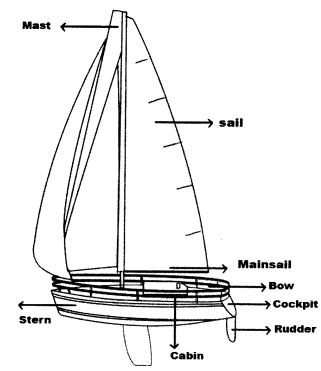
2. Here is some information downloaded from the Internet on lie Amsterdam. You can view images of the isle if you go online.
3. Locate lie Amsterdam on the world map.
(Refer to Oxford Atlas and look for lie Amsterdam.).
These Solutions are part of NCERT Solutions for Class 11 Biology. Here we have given NCERT Solutions for Class 11 Biology Chapter 4 Animal Kingdom.
Question 1.
What are the difficulties that you would face in the classification of animals if common fundamental features are not taken into account?
Solution:
There are millions of living organisms with a vast variety of shapes, sizes,s, and forms. They occur in a variety of habitats. It is difficult to identify and describe them at random, so they are classified into various categories. For identification and classification, different types of classification are required. There are fundamental features common to various individuals in relation to the arrangement of cells, body symmetry, nature of coelom, patterns of digestive, circulatory, or reproductive systems, etc. These features are used in the classification of animals.
Question 2.
If you are given a specimen, what are the steps that you would follow to classify it?
Solution:
Classification of specimen deals according to a systematic plan on the basis of their v similarities, differences and relationship.
We will take the following steps
(i) Level or grade of organisation:
There are different types of cell which are organised into functional units of progressively increasing complexity. Such as acellular, cellular, tissue, organ and organ system.
(ii) Pattern in organ system :
There are different organ system in which specific group of organs work together to do a specific function. Such as digestive organs in digestive system. Respiratory organs in respiratory system, etc. in animal body.
(iii) Symmetry:
In animals, 4-types of symmetry are seen. These are spherical, radial, bilateral, Asymmetrical species are classified according to symmetry.
(iv) Diploblastic and triploblastic organisation: According to number of germ layers which differentiate at the time of gastrulation in developing embryo. Species are classified as diploblastic i.e. two germ layer and Triploblastic i.e. three germ layers.
(v) Body cavity or coelom:
According to types of coelom, species are classified into acoelom, pseudocoelom and eucoelom animals.
(vi) Segmentation:
Species are classified according to segmentation. It is of three types i.e. pseudometamerism or false segmentation, internal and external segmentation.
(vii) Notochord:
On the basis of notochord, animals or species are divided into chordates and non-chordates.
We will follow the above steps in classification of animal, then fair idea of that animal can be derived.
Question 3.
How useful is the study of the nature of body cavity and coelom in the classification of animals?
Solution:
Coelom is the gap between gut and body wall. Coelom is the characteristic feature of complex or higher animals while lower animals like Platyhelminthes are acoelomate. The absence of coelom indicates that the animal is yet to develop a functional division of labour to carry out various activities. So the coelom characterises complexity of the animals and represents organic evolution.
There are three types of coelom
(i) Acoelom – It means absence of body cavity which is due to the failure of mesoderm to cavitate during embryogency, so there is no coelom, no peritonium. ex-porifera, colenterata, etc.
(ii) Pseudocoelom — It means presence of coelom that develops from the blastocoel but not lined by mesoderm, ex-nematodes, etc.
(iii) Eucoelom – It means hue coelom, which is lined by mesoderm resulting in tube within -tube design.
ex- higher invertebrates, chordates, etc.
Question 4.
Distinguish between intracellular and extracellular digestion?
Solution:
Question 5.
What is the difference between direct and indirect development?
Solution:
In oviparous animals, the newly hatched young may resemble the adult. Such a development is called direct development. In some cases, the young hatched from eggs do not resemble the adult. These young are called larvae, nymphs, or naiad. They lead an independent life for some period and finally undergo important change to become adults. These changes from larvae to adults are called metamorphosis and such a development is called indirect development.
Question 6.
What are the peculiar features that you find in parasitic Platyhelminthes?
Solution:
Members of Platyhelminthes possess the following characteristics.
Question 7.
What are the reasons that you can think of for the arthropods to constitute the largest group of the animal kingdom?
Solution:
The phylum Arthropoda constitutes the largest group of animals which include many economically important insects. Over two-thirds of all named species on earth are arthropods. They have an organ-system level of, body organization. They are bilaterally symmetrical, triploblastic, segmented, and acoelomate animals. The body of arthropods is covered by a chitinous cuticle which forms the exoskeleton. The body segments are fused to form the head, thorax, and abdomen. They have jointed appendages. The appendages are variously modified to form antennae, mouthparts, pincers, or walking legs.
The digestive system is complete. Respiratory organs are gills, book-gills, book lungs, or tracheal systems. The circulatory system is open type. The nervous system is almost similar to that of the annelids. Sensory organs include antennae for perceiving odor, receptors for taste, eyes, statocysts or balance organs, and sound receptors. Excretion takes place through green glands or malpighian tubules. They are mostly dioecious, Reproduction is sexual. Fertilization is usually internal. They are mostly oviparous. Development may be direct or indirect, passing through many larval stages. The process of transformation of a larva into an adult is called metamorphosis.
Question 8.
Water vascular system is the characteristic of which group of the following:
(a) Porifera
(b) Ctenophora
(c) Echinodermata
(d) Chordata
Solution:
Echinodermata – Its vascular system with tube feet helps in locomotion. A perforated plate , madreporite, permits entry of water into ambulacral system which also help in food and gas transport system.
Question 9.
“All vertebrates are chordates but all chordates are not vertebrates”. Justify the statement.
Solution:
The members of subphylum Vertebrata possess notochord during the embryonic period, which is replaced by a cartilaginous or bony vertebral column in the adult. Thus, all vertebrates are chordates but all chordates are not vertebrates. Besides the three basic chordate characters, vertebrates have a ventral muscular heart with two, three, or four chambers, kidneys for excretion and osmoregulation, and paired appendages which may be fins or limbs.
Question 10.
How important is the presence of an air bladder in Pisces?
Solution:
The class Osteichthyes possesses Air bladder. It helps the organism in regulating buoyancy. If the air bladder were absent the animal had to swim constantly to avoid sinking.
Question 11.
What are the modifications that are observed in birds that help them fly?
Solution:
The birds are adopted for flying by reducing the weight and other modifications which are as follows :
Question 12.
Could the number of eggs or young ones produced by an oviparous and viviparous mother be equal? Why?
Solution:
Normally the number of eggs produced by oviparous is greater than the number of young ones by viviparous. The development of young ones is oviparous takes place outside the mother whereas in the viviparous the development of the embryo takes place inside the uterus of the mother hence a viviparous mother can have very less number of embryos at a time in her uterus. Whereas oviparous mothers have no need to feed their young ones (embryos) until hatched. Hence, largest in number.
Question 13.
13. Segmentation in the body is first observed in which of the following:
(a) Platyhelminthes
(b) Aschelminthes
(c) Annelida
(d) Arthropoda
Solution:
(c) Annelida.
Question 14.
Match the following:
(a) Operculum (i) Ctenophora
(b) Parapodia (ii) Mollusca
(c) Scales (iii) Porifera
(d) Comb plates (iv) Reptilia
(e) Radula (v) Annelida
(f) Hair (vi) Cyclostomata and Chondrichthyes
(g) Choanocytes (vii) Mammalia
(h) Gill slits (viii) Osteichthyes
Solution:
(a) Operculum (viii) Porifera
(b) Parapodia (v) Annelida
(c) Scales (iv) Reptilia
(d) Comb Plates (i) Ctenophora
(e) Radula (ii) Mollusca
(f) Hair (vii) Mammalia
(g) Choanocytes (iii) Porifera
(h) Gill slits (v) Cyclostomata and Chondrichthys
Question 15.
Prepare a list of some animals that are found
parasitic on human beings.
Solution:
VERY SHORT ANSWER QUESTIONS
Question 1.
What is common name of Euspongia ?
Solution:
Bath sponge
Question 2.
Name the class which is characterised by pneumatic bones.
Solution:
Aves
Question 3.
Give the characteristic feature of Echinodermata.
Solution:
Water vascular system
Question 4.
Name the phyla which shows metamerism.
Solution:
Annelida, Arthropoda and Chordata.
Question 5.
Name two animal groups with incomplete digestive tract.
Solution:
Cnidariaandplatyhelminthes.
Question 6.
Name a fresh water sponge and coelenterate.
Solution:
Spongilla and Hydra
Question 7.
What is radula ?
Solution:
Rasping organ of molluscs.
Question 8.
Name two characteristic organs of chordates.
Solution:
Notochord and gill slits.
Question 9.
To which phyla Balanoglossus belong ?
Solution:
Hemichordata
Question 10.
Name two flightless birds.
Solution:
Ostrich, Kiwi
Question 11.
Give one example each of ectothermal and endothermal animals.
Solution:
Reptiles, mammals.
Question 12.
Give one example of cephalochordata.
Solution:
Branchiostoma (Amphioxus)
Question 13.
Why do lampreys and snakes lack girdles ?
Solution:
Due to lack of limbs.
Question 14.
What is the difference between epidermis of invertebrates and vertebrates ?
Solution:
Epidermis is a stratified epithelium in vertebrates and a simple epithelium in invertebrates.
Question 15.
Mention modification of coelom in echinoderms.
Solution:
A part of the echinoderm coelom is modified into a water-vascular system for help in locomotion.
Question 16.
What are setae ?
Solution:
Locomotive organs of phylum annelida.
Question 17.
What are endothermic animals ?
Solution:
Endothermic animals (birds and mammals) generate most of their body heat by metabolism.
Question 18.
Why is the Ornithorhynchus considered an 3 exceptional mammal ?
Solution:
Ornithorhynchus, though a mammal, lays egg and has a cloacal aperture.
SHORT ANSWER QUESTIONS
Question 1.
What are pneumatic bones ? Where do you find them?
Solution:
Bones having air spaces in them are called pneumatic bones. Birds have such types of bones to make body light for flying.
Question 2.
How do earthworm and leech differ with regard to their coelom ?
Solution:
Coelom is spacious in earthworm and greatly reduced in leech by formation of botryoidal tissue in it.
Question 3.
Cite unique features of nematodes.
Solution:
Syncytial epidermis, pseudocoel, non-muscular intestine and body wall musculature of longitudinal fibres only.
Question 4.
What is marsupium ?
Solution:
Marsupium is pouch on the females belly for rearing the young one in metatherian mammals. e.g. Kangaroo.
Question 5.
Why is coelentron called gastrovascular cavity ?
Solution:
It is a cavity in which both digestion and circulation occur.
Question 6.
What is the fate of notochord in higher chordate ?
Solution:
Notochord is replaced by vertebral column partly or fully in chordates.
Question 7.
State the two types of fishes. Give their examples.
Solution:
The two types of fishes are
(1) Chrondrichthyes example Trygon, electric ray
(2) Osteichthyes example Rohu, Sea horse
Question 8.
What is metamerism?
Solution:
It is a phenomenen found in organisms like earth worm that they have their bodies segmented and this parttem is called metameric segmentation.
Question 9.
Why are Urochordates called Tunicata?
Solution:
As the adult bodies of Urochordata is covered by a tunic like cover to these are called Tunicata.
Question 10.
Give an example of an organism showing.
(1) Radial symmetry
(2) Bilateral symmetry
Solution:
Radial symmetry: Star fish Bilateral symmetry: Octopus, men.
LONG ANSWER QUESTIONS
Question 1.
(i) What are different symmetry that exists in animal kingdom.
(ii) Distinguish between diploblastic and triploblastic
Solution:
(a) Asymmetrical symmetry
I. In many animals the body can not be divided in two equal halves on any plane.
II. Ex. Amoeba being irregular in shape, some sponges with various branching. Gastropod molluscs (snails, conch) have no symmetry due to torsion in embryonic stage.
(b) Radial symmetry
I. Any plane passing through a central axis of the body divides the organism into two identical halves.
II. Examples are Coelentrates, ctenophores and echinoderms.
(c) Bilateral symmetry
I. In most animals body can be divided into two equal halves on only one plane, hence body has left and right sides front and rear (back) sides; anterior and posterior ends; dorsal and ventral sides.
II. Their advance symmetry and such animals are most mobile.
Diploblastic animals: Animals in which cells are arranged in two embryonic layers, an external ectoderm and internal endoderm are called diploblastic animals.
Triploblastic animals: Animals in which developing embryo has the third germinal layers, mesoderm, in between the ectoderm and endoderm are called triploblastic animals.
Question 2.
Describe economic importance of the largest phylum.
Solution:
The largest phylum is Arhtropoda and its economic importance is as follows:
Question 3.
What are the peculiar characters of Aschelminthes?
Solution:
(i) The body of aschelminthes is circular in cross-section, hence named round worms.
(ii) They may be free living, a quatic and terrestrial or parasitic in plants and animals.
(iii) They have organ-system level of body organisation.
(iv) They are bilaterally symmetrical, triploblastic andpseudocoelomate.
(v) Alimentary canal is complete with well developed muscular pharynx.
(vi) An excretory tube removes body waste from the body cavity through the excretory pore.
(vii) Sexes are separate (dioecious), i.e., males and females are distinct. Often females are longer than males.
(viii) Fertilisation is internal and development may be direct or indirect.
(ix) Examples. Ascaris (Round worm), Wuchereria (Filaria worm), Ancylostoma (Hookworm).
We hope the NCERT Solutions for Class 11 Biology at Work Chapter 4 Animal Kingdom, help you. If you have any query regarding NCERT Solutions for Class 11 Biology at Work Chapter 4 Animal Kingdom, drop a comment below and we will get back to you at the earliest.
Here we are providing NCERT Solutions for Class 11 English Hornbill Chapter 5 The Ailing Planet: the Green Movement’s Role. Students can get Class 11 English The Ailing Planet: the Green Movement’s Role NCERT Solutions, Questions and Answers designed by subject expert teachers.
The Ailing Planet: the Green Movement’s Role Understanding the text
Question 1.
Locate the lines in the text that support the title ‘The Ailing Planet’.
Answer:
(a) “The earth’s vital signs reveal a patient in declining health.”
(b) a new awareness has now dawned upon the most dangerous animal (man) in the world.”
(c) “Are we to leave our successors a scorched planet of advancing deserts, impoverished landscapes and ailing environment?”
(d) “.. .In large areas of the world, human claims on these systems are reaching an unsustainable level, a point where their productivity is being impaired.”
(e) “When this happens, fisheries collapse, forests disappear, grasslands are converted into barren wastelands, and croplands deteriorate.”
(f) “…several species of life face extinction as a result of its destruction.”
(g) “It has been well said that forests precede mankind; deserts follow.”
(h) “The world’s ancient patrimony of tropical forests is now eroding at the rate of forty to fifty million acres a year, and the growing use of dung for burning deprives the soil of an important natural fertiliser.”
(i) “The World Bank estimates that a five-fold increase in the rate of forest planting is needed to cope with the expected fuel wood demand.” “….We were saying that we are losing the forests at an acre a second, but it is much closer to an acre-and-a-half to a second.”
(j) “.. .highlighted the near catastrophic depletion of India’s forests over the last four decades.”
(k) “India, according to reliable data, is losing its forests at the rate of 3.7 million acres a year.. .The actual loss of forests is estimated to be about eight times the rate indicated by government statistics.”
(l) “A three-year study warns that the environment has deteriorated so badly that it is ‘critical’ in many of the eighty- eight countries investigated.”
(m) “For the first time in human history we see a transcending concern—the survival not just of the people but of the planet.”
(n) “The environmental problem does not necessarily signal our demise, it is our passport for the future.”
Question 2.
What does the notice ‘The world’s most dangerous animal’ at a cage in the zoo at Lusaka, Zambia, signify?
Answer:
In the zoo at Lusaka, Zambia, outside a cage there is a notice that reads, “The world’s most dangerous animal.” Inside the cage there is no animal but a mirror where one can see oneself. It is an endeavour to make humans realise how destructive they are. They are the cause of the destruction of thousands of species. We have done this by destroying their habitats. This is an attempt to make human beings introspect about their destructive deeds. It is an attempt to help us realise the wisdom of shifting from a system based on domination to one based on partnership.
Question 3.
How are the earth’s principal biological systems being depleted?
Answer:
Mr Lester R. Brown in his book, The Global Economic Prospect, points out that the earth’s four principal biological systems fisheries, forests, grasslands, and croplands form the foundation of the global economic system. In addition to supplying our food, these four systems provide virtually all the raw materials for industry.
Human claims on these systems are reaching an unsustainable level, a point where their productivity is being impaired. As a result, fisheries collapse, forests disappear, grasslands are converted into barren wastelands, and croplands deteriorate. Since tropical forests are, in the words of Dr Myers, “the powerhouses of evolution”, several species of life face extinction as a result of their destruction.
Question 4.
Why does the author aver that the growth of world population is one of the strongest factors distorting the future of human society?
Answer:
Growing population is one of the strongest factors distorting the future of human society. A three-year study using satellites and aerial photography conducted by the United Nations, warns that the environment has deteriorated so badly that it is ‘critical’ in many of the eighty-eight countries investigated. India is losing its forests at the rate of 3.7 million acres a year. The actual loss of forests is estimated to be about eight times the rate indicated by government statistics.
The Ailing Planet: the Green Movement’s Role Talking about the text
Discuss in groups of four.
Question 1.
Laws are never respected nor enforced in India.
Answer:
Article 48 A of the Constitution of India makes available that “the State shall endeavour to protect and improve the environment and to safeguard the forests and wildlife of the country”. But the cause of unending distress is the fact that laws are never respected nor imposed in India.
For example, the Constitution says that “casteism, untouchabitity and bonded labour” shall be eradicated, but this has not happened even after several years of the functioning of the Constitution. A recent report of our Parliament’s Estimates Committee has highlighted the appalling exhaustion of India’s forests over the last four decades. India is losing its forests at the rate of 3.7 million acres a year but the actual loss of forests is likely to be about eight times more than this, despite laws.
Question 2.
“Are we to leave our successors a scorched planet of advancing deserts, impoverished landscapes and an ailing environment?”
Answer:
The earth’s four principal biological systems fisheries, forests, grasslands, and croplands form the foundation of the global economic system. In large areas of the world, human claims on these systems are reaching an unsustainable level, a point where their productivity is being impaired. According to Dr Myres, the tropical forests that are the powerhouses of evolution, as they house innumerable species, are facing extinction.
It has been said that forests pave the way for man’s survival while deserts come after the annihilation of life. The world’s tropical forests are now wearing away at the rate of forty to fifty million acres a year. Expressing his concern, Mr L.K. Jha, raised this question in the first Brandt report. He felt it was unfair to leave for our future generations a seared planet with a growing number of deserts, a landscape deprived of nutrients and natural beauty.
Question 3.
“We have not inherited this earth from our forefathers; we have borrowed it from our children”.
Answer:
For the first time in human history we see an excessive worry about the survival not just of the people but also of the planet. We have begun to take a holistic view of the very passport for the future. The emerging new world vision has ushered in the Era of Responsibility. It is a holistic view, an ecological view, seeing the world is not something to be exploited for our good but as an inheritance to be preserved for future generations.
Question 4.
The problems of overpopulation that directly affect our everyday life.
Answer:
Growing population is the main factor changing the future of human society. In 1800, the population was merely one billion. Another billion was added to it by 1900. By the twentieth century the population increased by another 3.7 billion. The present world population is estimated at 5.7 billion.
Every four days, the world population increases by one million. Controlling the population growth will improve our general health. Moreover, development may not be possible if increase in numbers continues. The rich get richer, and the poor produce children, which is the cause of their poverty. It adds to the number of unemployed persons. If this is not checked, the poor will die of starvation.
The Ailing Planet: the Green Movement’s Role Thinking about language
The phrase ‘inter alia’ meaning ‘among other things’ is one of the many Latin expressions commonly used in English.
Find out what these Latin phrases mean.
The Ailing Planet: the Green Movement’s Role Working with words
I. Locate the following phrases in the text and study their connotation.
II. The words ‘grip’, ‘dawn’, ‘usher’, ‘coin’, ‘passport’ have a literal as well as a figurative meaning. Write pairs of sentences using each word in the literal as well as the figurative sense.
1. grip: The baby gripped my finger with her tiny hand.
2. dawn:
3. usher:
4. coin:
5. passport:
The Ailing Planet: the Green Movement’s Role Things to do
1. Make posters to highlight the importance of the Green Movement.
2. Maintain a record of the trees cut down and the parks demolished in your area, or any other act that violates the environment. Write to newspapers reporting on any such acts that disturb you.
32/4, Mehrauli, New Delhi
12 February 20XX
The Editor
Navyug Times
Kasturba Gandhi Marg, New Delhi-1
Subject: Malls trampling Delhi’s green belt
Dear Sir,
Part of the Aravalli range, the Delhi Ridge, is an icon of greenery and part of the capital’s heritage. But over the years, much of the Ridge has disappeared, with the most recent threat coming from swanky hotels and malls.
The Ridge is home to many endemic plant species and still remains an important visiting stop to many migratory birds as they journey onwards to other parts of the subcontinent. Moreover, it cools the hot winds from the deserts of the neighbouring state of Rajasthan before they reach the city and stashes away welcome raindrops to boost dipping groundwater levels.But over the years, much of the Ridge has disappeared under the brick and mortar that now define most Indian cities.
A worst-case scenario is on display in the Ridge area in Vasant Vihar, where trees are being cut down to build swanky hotels and malls. Such expansion that puts more soil under cement and replaces forested areas with concrete is profoundly altering the environmental landscape. The health of our natural endowments has now become the source of much anxiety and consternation amongst the residents of the area.
We remain unclear as to both the quality and the quantity of our ecological footprint and whether we have taken actions that will lead to negative short-term and long-term environmental consequences. It is essential to halt this march towards destruction of the Ridge. The Ridge forest is protected under the master plan and must remain so. Residents must actively protest against this degradation of their environment.
Yours sincerely,
(Name …)